Table of Contents
Link building is always a hot-button issue in the SEO community. After a tumultuous 2024, we’ve heard (and felt) that SEOs and organizations are becoming more skeptical about the impact of links and link building.
We teamed up with Garrett French of Citation Labs to truly understand where things are going in 2025.
Garrett and his team have been building links since the early days of SEO, and I trust no one better to help us identify market trends and get to the bottom of how link building is used by organizations worldwide.
So, without further ado, here’s our Link Building Trends Report.
Feel free to use any/all of the data in the report below, but please link and attribute to BuzzStream and Citation Labs.
Table of Contents
- 61% manage link building in-house, but agencies still play a role.
- 66% struggle with identifying backlink tactics, making strategy a key challenge.
- Only about a third (29%) find their link building efforts successful.
- 68% prioritize links to blog posts, but only just 41% focus on product pages.
- 75% are given 6 months or fewer to prove the value of their link building efforts.
- Only 29% say link-building budgets are easy to secure.
- 56% expect their link building budgets to increase in 2025.
- Just 11% have a repeatable process for getting cited in AI.
- Only 40% feel reports effectively convey the value of link building.
Section 1
Link Building Management
Tracking, reporting, and executing link building efforts is a full-time job for many organizations. So, we wanted to start with some baseline information on how link building is managed in major organizations.
(Note: this section examines how link building is managed in-house only. The rest of the report is from agencies, freelancers, consultants, and in-house.)
1
For those we surveyed who work in-house at an organization (~150 respondents), most organizations (61%) manage their link building entirely in-house.
Almost a third do some sort of mix between agencies/freelancers and in-house teams.
Surprisingly, however, of those who work with external link builders, only 30% are fully confident in the results:
1a
This lack of trust in agency or freelancer work may be partly due to Google’s algorithm updates in 2024, which made many once-trusted link building strategies less scalable.
The agencies that are less willing to adjust are the ones I’ve seen getting impacted the most.
Remember, if you don’t trust the work or provide excessive oversight, there is no reason to stay with an agency or freelancer who doesn’t build good links!
2
Our responses show that most organizations strive to improve at building links somehow.
66% aim to improve selecting the best backlink tactics for their organization.
Reporting on impact is the second most sought-after skill (63%), and most organizations wish to improve upon it.
This aligns with our State of Digital PR report, where measuring impact was the most challenging aspect.
It is heartening to see that many are striving to improve, but it again shows some uncertainty about what is working and why.
In the next section, we’ll dig into what organizations are actually doing to get results.
Section 2
Link Building Strategy
Building a successful strategy to gain links for your business can take years of trial and error.
And because no two organizations are the same, it’s never a one-size-fits-all approach.
Here, we seek to understand how organizations build their strategies.
3
Only about a third (32%) follow a documented and repeatable process.
Most (68%) reported having a more spontaneous or unplanned link building approach.
This spontaneity can cause problems when testing and measuring success (which you’ll see in the next section).
EXPERT OPINIONS
Is it better to follow a documented/repeatable link-building process or stay flexible?

CEO, Foundation Marketing
“Brands and marketers need a link building wake-up call and this report delivers it. You need a process that’s not just a rigid checklist, but a living, breathing strategy that can dance with unpredictable shifts. I’ve seen too many teams treat their link building like a static spreadsheet—and spoiler alert: that’s why they’re stuck at the bottom of the results page.
The Link Building Trends Report dropped a truth bomb: only 29% of teams are actually crushing their link building efforts. Why? Because they’re trapped between two deadly extremes—total chaos or complete stagnation. I think the best link building teams strive to find a balance between scalable processes and flexibility. “

Founder, Digitaloft
“Having a documented process definitely helps with training a team and ensuring consistency, but it shouldn’t ever be so tight that it limits creativity.
I often think of these as frameworks, rather than tight processes. Something that a team can work within yet still have the flexibility to adjust things to the campaign being worked on.
For example, repeatable processes are a must for end-to-end campaign production, in terms of the steps that should be followed.
Yet ideation, for example, should be more a case of strong guidance, in my opinion. No two people ideate the same, so here having a strict process will limit the output. You absolutely do need to have frameworks here though; guidance on different ways to ideate.
It’s all about striking a balance between creativity and processes, but about keeping things flexible enough to deviate from the ‘norm’ as and when it is needed.
And a lot of the time, how much these robust processes should be adhered to depends on the seniority of the person working on the campaign; for juniors, they’re a lot more useful to follow almost step-by-step, than an experienced marketer who knows when (and why) to deviate and pivot.”
4
Similarly, only a small percentage (16%) of respondents stick to a fixed set of strategies.
Most respondents (84%) appear to keep a flexible approach.
Now that we know how strategies are set, let’s understand some of the link builders’ goals.
5
When it comes to pages to prioritize in link building campaigns, blog posts are most common (68%), followed by the homepage (44%).
Fewer (41%) try to build links to product pages, and very few want to build links to sales/demo pages.
While many lean on link building for its ability to raise domain authority and make it easier to rank for key terms, you can also drive links to sales pages.
Building links to sales-focused pages is difficult, but not impossible.
Citation Labs has a great guide on the subject that I highly recommend checking out.
The key to getting links to sales pages is to add citation-worthy elements (like first-party data) by answering the questions your audience doesn’t know to ask.
In the following question, we dug deeper to understand the intricacies of this approach from organizations.
6
When digging into the link-building page strategy, there is an even split between those who prefer to build links to pages with sales-focused CTAs (43%) and those who don’t care what kind of page they build links to (41%).
But, only 16% specifically seek to build links to pages with sales-focused CTA.
It still seems that most people are comfortable with the blended approach. However, it limits the potential impact of gains from link building.
EXPERT OPINIONS
Why don’t more organizations build links to pages with sales-focused calls to action?

Co-Founder, Fractl
“This strategy is nuanced, so my quote represents the depth of the challenge and potential solutions: When earning links from authoritative sources, journalists and publishers prioritize content that educates, entertains, or provides “breaking news” in the form of fresh, relevant, and actionable data their audience values — think original data studies, interactive tools, expert commentary on trending news, or thought leadership addressing industry FAQs.
Ultimately, earning links and brand coverage is about creating content worth citing.
Unfortunately, most teams struggle to earn high-quality links to sales-focused pages because those pages rarely offer significant value beyond the brand’s conversion goal. Few reputable sites will link to an advertorial page without payment.
However, there are ways to improve your odds of earning links to these “money pages,” such as incorporating robust FAQs featuring subject matter experts, proprietary industry research, and other strategies that enhance the perceived value of the page. When done right, this style of conversion-focused content can increase your chances of earning links from relevant mid-tier publishers in your niche, as well as from .edu and .gov resource pages.
Still, SEOs often (and understandably) prioritize UX and conversion optimization over earned media enhancements on key money pages. But you don’t always need to kill two birds with one stone.
We’ve repeatedly seen that earning links to top-funnel or mid-funnel assets — like newsworthy data journalism campaigns or robust evergreen guides — naturally attracts and scales backlinks from authoritative publishers.
This strengthens a brand’s citations, trust signals, and Domain Authority, lifting rankings across the entire site, while preserving the unique intent of these two distinct strategies.”
If only some brands are focused on sales pages and others aren’t, how does everyone measure impact?
We look at this in the next section.
Section 3
Measuring Impact
Like SEO, measuring the impact of backlinks takes time. However, defining “impact” differs from brand to brand.
In this section, we seek to understand better how organizations look at the impact of link building.
7
Let’s start at the beginning. It will be tough if leadership doesn’t buy into link building.
Luckily, 65% of the organizations have support from their leadership in link building as a long-term strategy.
However, “long-term” seems a bit short.
Of those with leadership support, over half of the respondents (60%) get just 3–6 months to show the value of their link building efforts:
7a
This is somewhat in line with our findings regarding how long it takes to see the impact of digital PR-related link building.
Most said it takes about 3–6 months. However, it depends on the process.
A “passive link building” approach (like our link building statistics post) will take 8-12 months to see impact sitewide because it takes longer to generate links.
EXPERT OPINIONS
How do you recommend showing the value of a link building program?

CEO, Root Digital
“Sometimes it can be hard for a link builder – in whatever shape that looks like – to properly communicate value.
Impact on revenue is always the goal. It has to be. But there are two sides to impacting revenue when it comes to link building programs; direct and indirect conversions.
Direct conversions are more straight forward to measure, but typically the links capable of driving direct conversions are a small part of a link profile. Here we’re talking having your product or service featured in a ‘top 10’ or ‘best x’ list from sites dominating informational search or a platform people use to find products or services in your industry. Building and then maintaining relationships with those who write and update these lists is key, and measuring the impact of your link is extremely straight forward with any basic traffic analytics tool.
Indirect conversions are where 80%+ of a link builders focus will be, and this sits firmly within the realms of SEO. Therefore, the primary goal becomes rankings-based, which can be at a domain-wide level or if can be more specific to individual pages.
Links, along with other trust and authority based metrics, are and will continue to be a huge element of any search based algorithm. However, the value of a link is hard to measure especially as a site can suffer from technical SEO issues or content quality management that is often out of your control.
My recommendation would be to focus both at a domain-level for tracking keyword performance, and also on a group of key pages you’re buildings link to directly or funnelling equity towards. This should ideally be a few pages – not one. Otherwise you’re value proposition is at risk from any tech SEO hiccups or product teams redesigning the key page in way search engines don’t like.
Measure rankings and other sources of traffic before your link building program starts. Do so continuously throughout your link building efforts, and a final wrap up towards the end. You want to measure the change in traffic to the page and, most importantly, the change in transactional value overall.
We did this years ago for a global travel client and through tracking 5 key pages and using our tracked keyword performance and conversion values in GA, we could communicate our impact as an increase equalling a 2,160% ROI from the 6 figure sum they’d invested in us – over £2m in increased revenue directly to those 5 pages.”
Now that we know how long they have to show impact, let’s see how organizations are doing.
8
Overall, only about a third (29%) find their link building efforts successful.
Most (44%) are just in the middle of the road.
EXPERT OPINIONS
In your experience, what do most successful teams do that you see others struggle with or ignore altogether?

BibiBuzz
“Every single link-building team goes through struggles. Why? Because at the end of the day, humans are placing the links.
Whether you’re asking for it, paying for it, or creating some bad-ass linkable asset or PR campaign, an editor is making the call on whether that link lands.
This human aspect brings unpredictability and a lack of control to the table.
Ask any link builder if they’ve ever struggled, and they’ll buy you a beer and cry on your shoulder. But this? This is exactly what separates the winners from the losers.
The teams that win aren’t the ones who never screw up—they’re the ones who screw up, learn from it, and adapt. They take the hit, tweak the strategy, and try again. They just. keep. going.
So bear that in mind, next time your campaign sucks. :)”
But let’s dig deeper into what “success” means.
9
OK, now we are getting somewhere.
Link builders evaluate the impact of a link primarily by looking at increased organic visibility for the target page (59%), followed by increased ranking (54%) and organic traffic growth (53%).
At the bottom, just 28% look at increased revenue from organic visits from referral pages.
Seeing such a disconnect between the bottom line and link building isn’t surprising, but it still speaks to the missed opportunities.
One way to connect the two is by showing link impact on revenue (increased visibility and traffic to key sales pages).
EXPERT OPINIONS
From your experience, what is the best way to show the impact of an individual link?

Marketing & Partnerships Manager, Candour
“I think that a boost in rankings for the target page is the simplest and fastest way to see the impact of a single backlink.
For me, relying on domain-wide signals like domain authority just isn’t realistic for a single backlink.
If your target page is a product page or specific article rather than the homepage, you can easily narrow it down and see if that page has grown in visibility from your link-building efforts.
In the following few weeks, I’d also check for an increase in traffic to that page.
Growth in organic traffic (from the improved rankings) and referral traffic (users arriving directly via that link) is usually the next step in the success of a link-building campaign.”
But now that we know that impact is primarily tied to ranking and traffic growth, let’s look at how sites report on link building.
Section 4
Link Building Reporting
Reporting is probably essential to a link builder’s job if they want to keep it.
We’ve understood that they don’t necessarily focus on linking link building to business goals.
We compiled crucial questions about benchmarking and goal setting to understand better how organizations report (or potentially underreport) their link-building efforts.
10
Most link builders (61%) align their goals with KPIs (key performance indicators).
Almost one-quarter (22%) don’t align goals to any framework.
Unsure how you should be measuring? Citation Labs has outlined many strategies for measuring link building with your CMO in mind.
EXPERT OPINIONS
What are some of the main KPIs you’d recommend tracking for link building programs?

Co-Founder + CEO, dofollow.com
“As an agency, we always emphasize that the value of link building can’t be measured by any one metric. The KPIs we monitor depend on the client’s goals, but a few always indicate a meaningful impact.
First, we look at growth in organic traffic to the pages we’re building links to. It’s one of the clearest indicators that links are doing their job and driving visibility where we want it. Keyword rank gains—especially for commercial or bottom-of-funnel terms—are another significant indicator we track. They help confirm the value of the links to SEO over the long term.
We also closely monitor referring domain quality and relevance over quantity. A few high-authority, well-placed links are better dozens of spammy ones. And if they’re also driving engagement-referral traffic, that’s all the better—proof that the link adds value beyond search engines.
Where possible, we also consider the conversions or revenue generated by the target pages. Making those connections is not always straightforward, but assigning links to business outcomes is how we maintain stakeholders’ trust.
One metric I don’t see teams leveraging as much as they could is benchmarking. Comparing performance between unlinked and linked pages is one of the most effective ways to show impact—however, as the report shows, only a quarter of organizations are leveraging it.
And finally, as AI continues to advance, we’re starting to try and check if content we’re pointing to is being quoted in AI-powered results. It’s a new KPI, but I believe it will become more and more important in the future.”
11
There are some critical gaps in link building reporting.
Only about half (53%) believe their link building reports are easy to understand.
Only 40% feel their reports effectively show the value of their link-building efforts, and about half (50%) want to see this improved.
As this case study from Citation Labs shows, it’s much easier to get buy-in when you can clearly show ROI and impact in a report.
EXPERT OPINIONS
What apps/programs/tools do you recommend to build link building reports?

Founder, Herculeanseo.com
“1. Website tech spend: One metric to get additional insights about a link is the website’s tech spend.
Builtwith tells you approximately how much a site is spending on its technology stack.
We can use website tech spend as a proxy for how much money they are spending on their site’s content and links.
2. Website traffic value: I like to report about the site’s Traffic value (Both aHrefs and Semrush report this metric)
A Link from a site with a higher STV is better than a site with a lower STV (Considering DR and monthly traffic are the same for both the sites).
3. Majestic’s Topical Trust flow: Majestic looks at a website’s entire link profile and categorizes each link according to the industry/niche it belongs to.
You might think getting a link from a site with decent DR, traffic and niche relevance is enough but sometimes under the hood, the site itself mostly has links from non relevant industries.
4. Fake DR: I report if the link opportunity has a manipulated DR or not.
5. Fake Traffic: Some webmasters are using bots to search for their Site’s brand name and clicking on the results.
SEO tools like aHrefs and semrush pick up these clicks (unbeknownst to the fact that these are not real clicks) and report it in their traffic metric.
So I also like to report if a site has fake traffic or not.”
Garrett and the team found that benchmarking is often missing from many reports to help show the clear impact of links on pages, so we asked directly in the next question.
12
Just one in four reported using benchmarking for their link building results.
Given that many organizations’ link-building strategies were somewhat spontaneous, it’s not surprising that over half don’t care about benchmarks.
But if you are trying to show the importance of link building within an organization, benchmarketing is a missed opportunity.
Using a control shows the value of link building by comparing page performance of pages targeted by link building campaigns against those not targeted.
Of the organizations that benchmark, 70% feel that benchmarking is very valuable in link building.
Said another way: Organizations that use benchmarking know it works — but only 1 in 4 are using this.
12a
If you’re considering starting, you can learn from what others are doing.
Of those who benchmark, 72% look at high-performing pages on their sites, and 65% look at pages on competitor websites.
12b
Looking at competitors can also give you a good starting point for benchmarks.
If you want to benchmark a team’s output, our digital PR study found that 29.5% can generate an average of 31+ monthly links if link numbers are your KPIs.
Other surveys, like Authority Hackers, found that beginners can generate seven links per month while those with 5+ years of experience can build 25+ links.
But don’t get lost in the numbers.
These days, quality links are much more critical than pure quantity. We’ve found that the number of links needed is usually much lower than you think.
Section 5
Link Building Budgeting
Although we didn’t survey this, I can say from experience that brands typically find themselves in a more manageable (and less stressful) position for building links when leadership understands and buys into the idea that SEO is important.
With that in mind, let’s look into how brands budget.
13
Only 29% of respondents claim getting a budget for link building is “very easy” or “somewhat easy.”
This makes sense when you think that brands have difficulty showing impact.
You most likely won’t get a budget if you can’t show impact.
For some context, the average digital PR link building budget is below $10K monthly, based on our same State of Digital PR survey.
One reason brands struggle with getting a budget is that their link-building goals don’t align with the areas leadership cares about most.
EXPERT OPINIONS
How do you communicate the value of link building in a way that gets you the budget you need to hit goals?

Owner, Sterling Sky Inc.
“We choose what sites to get links from by looking at these 4 factors:
1. Is the link indexed?
2. Is it followed?
3. Can you manipulate the anchor text?
4. How many pages rank on Google on the site you’re getting a link from?
As far as how we measure the impact the links have, we isolate link building from other SEO work and do it in stages so that it’s easier to tell what is actually impacting ranking.”

Managing Partner, Measured SEM LLC
“Personally I walk through this with a few steps:
1. First establishing their goals and budget for an engagement. We’re usually working as a general SEO / SEM vendor, so the client’s goals are typically driving more qualified leads and sales at an acceptable ROI.
2. From there, we’ll map the deliverables to the budget and give them a general sense of expected growth (and returns). This can vary significantly as a new site needs something completely different than a larger site, etc.
3. If there’s a gap at this point between the budget and the desired / expected results, I find showing specific metrics can be helpful. For example: here are the volume and quality of links your competitors – direct company competitors or broader SERP competitors – have versus what you have.
For visuals a quick comparison chart(s) can be great here, or even a call / Loom where you walk through the search results, use a tool like Ahrefs or SEM Rush, and really show them the difference between the sites they’re competing with and their site.
Increasingly, for companies showing an interest, we’ll also communicate the benefit of outreach, citations, and link building in getting higher visibility in LLMs as well.”
But why do brands invest in link building?
14
Most organizations invest in link building to improve organic traffic (68%) and improve rankings (68%).
For most SEOs, it’s no surprise that organic traffic is the top goal. We found strong evidence that links, especially digital PR, impact SEO significantly.
But if the traffic doesn’t ultimately lead to sales, it will be hard to continue building links.
Only half build links to increase sales/revenue (48%), and just 39% want to generate leads or email signups.
Now that we have a bit more behind-the-scenes information about how and why organizations invest, let’s look at the future of budgeting.
15
Despite Google’s constant harping about links “mattering less,” over half of respondents (56%) plan to invest more in link building in the next 12 months.
This bodes well for the industry and confirms the all-time highs in searches for “link building” via Google Trends.
People are interested, and brands seem willing to invest. Let’s see why:
15a
Of those investing more money in link building, the main reason is to help improve rankings (61%).
Just 9% will invest less in link building. Of those, here are some reasons why:
15b
The small number of organizations cutting link building budgets is mainly due to spending cuts (39%).
Let’s call out one more stat from the above: 9% of organizations plan to decrease their budget because of AI.
EXPERT OPINIONS
Should link building budgets increase or decrease in 2025, and why?

President & Co-Founder, AttorneySync
“I think more resources should be allocated to link building in 2025.
But I also think we need a major shift in how we’re thinking about links.
More resources should be deployed building links from sites with overlapping audiences.
We should prioritize links that generate business.
We should prioritize links that generate relevant traffic.
Generally speaking, we should ignore traditional link metrics (i.e. DA, nofollow, etc).
We need new metrics to measure link quality.”

Product Advisor, Technical SEO & Brand Ambassador, Ahrefs
“Definitely increase. We already know links help with search, but right now brands are focused on LLMs.
I think companies are waking up and realizing that they need to be part of all the conversations if they want to be in the output of LLMs.
Web mentions (sometimes linked), stats from studies shared through digital PR, quotes in blogs, social media mentions, and more all influence what is included in the output of LLMs.”
In the next section, we’ll look at AI in link building.
Section 6
AI in Link Building
Every day brings a new AI tool or technology update, and with it come articles discussing its impact on the SEO community.
So, we wanted to see what organizations doing link building think about AI’s impact.
16
Two-thirds (68%) believe link building will be more important (68%) in the next two years due to AI.
This is another win for the link building industry, and as we saw in the previous section, it may mean even more budget increases.
However, another way to look at this is that most respondents report they expect increases because of AI.
Those who believe link building will become somewhat/much more important are almost 2x as likely as their peers to report it’s easy to get budget for link building.
But let’s dig into why brands are so keen on AI.
17
Most respondents seem to prioritize getting citations in AI-generated results, with 62% saying it’s very or extremely important to their organization.
One study from Terakeet, published at the time of publication, showed that top-ranked transactional pages included in an AIO get 220% more clicks than those excluded.
However, the impact seems to vary.
Citation Labs study found that a query received just 25 clicks from an AI Overview, compared to over 200,000 visits from regular search results.
EXPERT OPINIONS
Do you think links will impact a brand’s ability to appear in AI search results? Why/Why not?

Founder, Citation Labs
“I do! It’s not just about net-new linking domains though.. it’s about citable elements on sales pages: first-party data, frameworks, quotable insights, answers to frequently UNASKED questions, expert-backed breakdowns.
Links – and us folks who build them – are how brands win distribution for those elements. Link Building’s how you get your content into the training data, and how you start showing up across the network of resources that LLMs reference most often.
With our LLM Growth services we’re targeting LLM-cited resources (the publishers, pages, and formats that show up in actual AI-generated answers). Then we work to earn mentions, citations, and links from those sources.
So yes links impact generative results… But it’s where you earn them – and how – that’s evolving at a dizzying pace.”

Co-Founder, BuzzStream
“Definitely. The AI models have knowledge cut-off dates, so they rely heavily on real-time web search to stay current and accurate. Given that authoritative links have remained a huge search ranking factor for 20+ years, I can’t see a future where they won’t play a big role in AI answers.
Other factors may grow in importance (e.g., structured data, semantic relevance), but links will continue to be essential for brands aiming to show up in AI-generated results.”

Founder, Digital Olympus
“I strongly believe that links and brand mentions will become must-have assets for AI results. This applies to both Google and AI agent results.
We can already see that LLM models rely heavily on the quality of sites and the context where your brand is mentioned.
Also, it’s crucial to ensure that your brand is listed in listicle posts recommending the top or best options.”
But this got me wondering if brands have figured out a way to get into the AI results…
18
Unsurprisingly, most organizations haven’t quite cracked the code on getting content cited in AI-generated results.
Just 11% claim to have a repeatable, reliable process.
We haven’t found the key to showing up in AI yet, but we do have one study showing how some AI datasets used high DA news publications to “curate” their datasets.
Garrett and the team at Citation Labs have identified a process to grow LLM visibility by analyzing how ChatGPT and other LLMs cite web content to answer decision-making prompts.
Their process—and tool that supports it—discovers and analyzes LLM-cited URLs, enabling brands to benchmark against competitors and develop visibility outreach strategies for LLM-cited resources.
EXPERT OPINIONS
Do you have any tips/tricks for getting brands mentioned in LLMs?
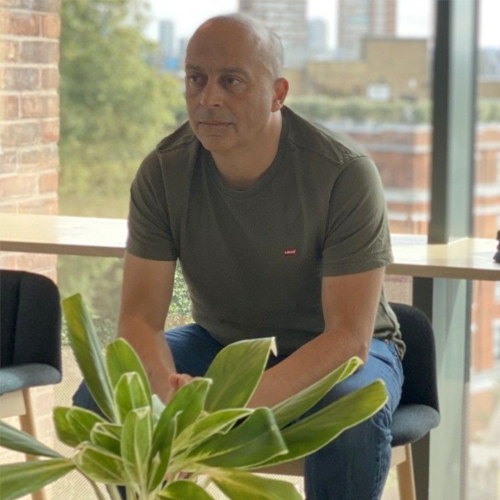
CEO, Reboot
“We’ve been playing around with increasing visibility for clients on LLMs for over a year and have developed some tactics that work very well. At the core of our approach is a concept we call “Context Wrapping”, ensuring that every mention of a brand, whether on its own site or in external publications, is wrapped with the sentiment we want LLMs to recognise.
For example, if your brand is Shai’s Pizzas, you’d want it associated with words like tasty, great, authentic, fresh ingredients. A well-crafted mention helps reinforce this perception in LLMs, a bit like this: “This great pizza tip was supplied by the authentic Italian pizza restaurant, Shai’s Pizzas, who use only the freshest ingredients”.
And the best way to achieve this? Digital PR with a slight difference. We basically take our learnings from the above and use it to slightly modify the way we write or press releases where we gently include some of the sentiment we want LLMs to consume. We call this AiPR.”
Okay, aside from trying to use links to get into AI, let’s see how else these organizations use AI.
19
The number one way that organizations use AI/LLMs for link building tasks is to create content, such as guest posts.
Although “experts” on social media might make it sound like you can scale thousands of posts using AI (remember the SEO heist?) I would be wary of using AI to write guest posts without a human.
So, in the last section, let’s see where users are actually getting their information.
Section 7
Education and Insights
2024 saw some of the craziest changes in SEO since the days of Penguin and Panda. Staying up-to-date and educated on the key trends and strategies is critical.
Here’s how most SEOs educate themselves.
20
Blogs and newsletters are the primary sources for link building education, with 70% of the responses.
Check out the Citation Labs blog or the BuzzStream Link Building Newsletter to stay current on the latest link building trends.
Section 8
Audience Breakdown
This last section helps break down the respondents from our report.
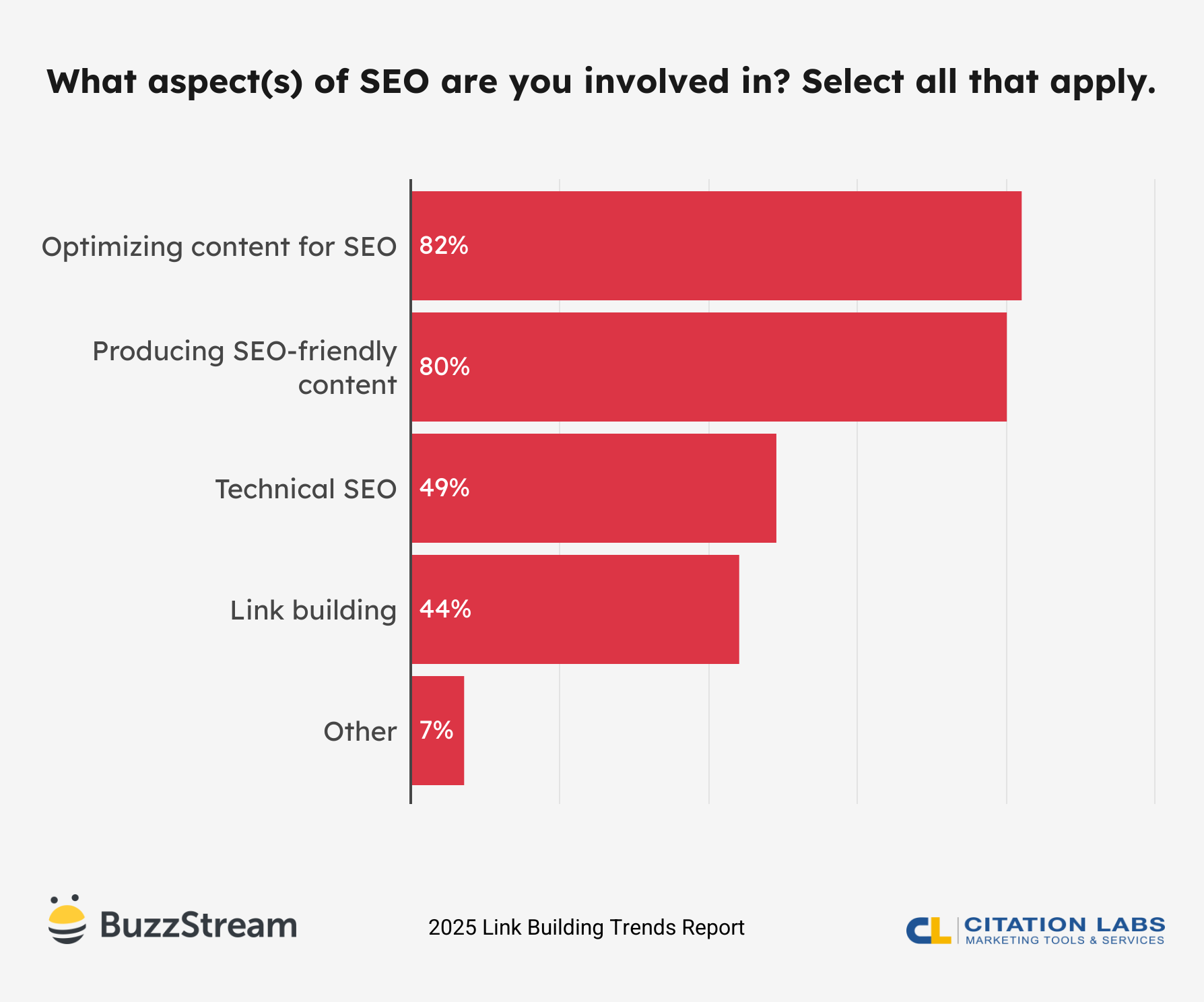
Most (82%) are involved in either optimizing or producing (80%) SEO content.

A majority of the respondents have worked in the business at least 3 years, and almost half (46%) have worked in SEO for 5+ years.
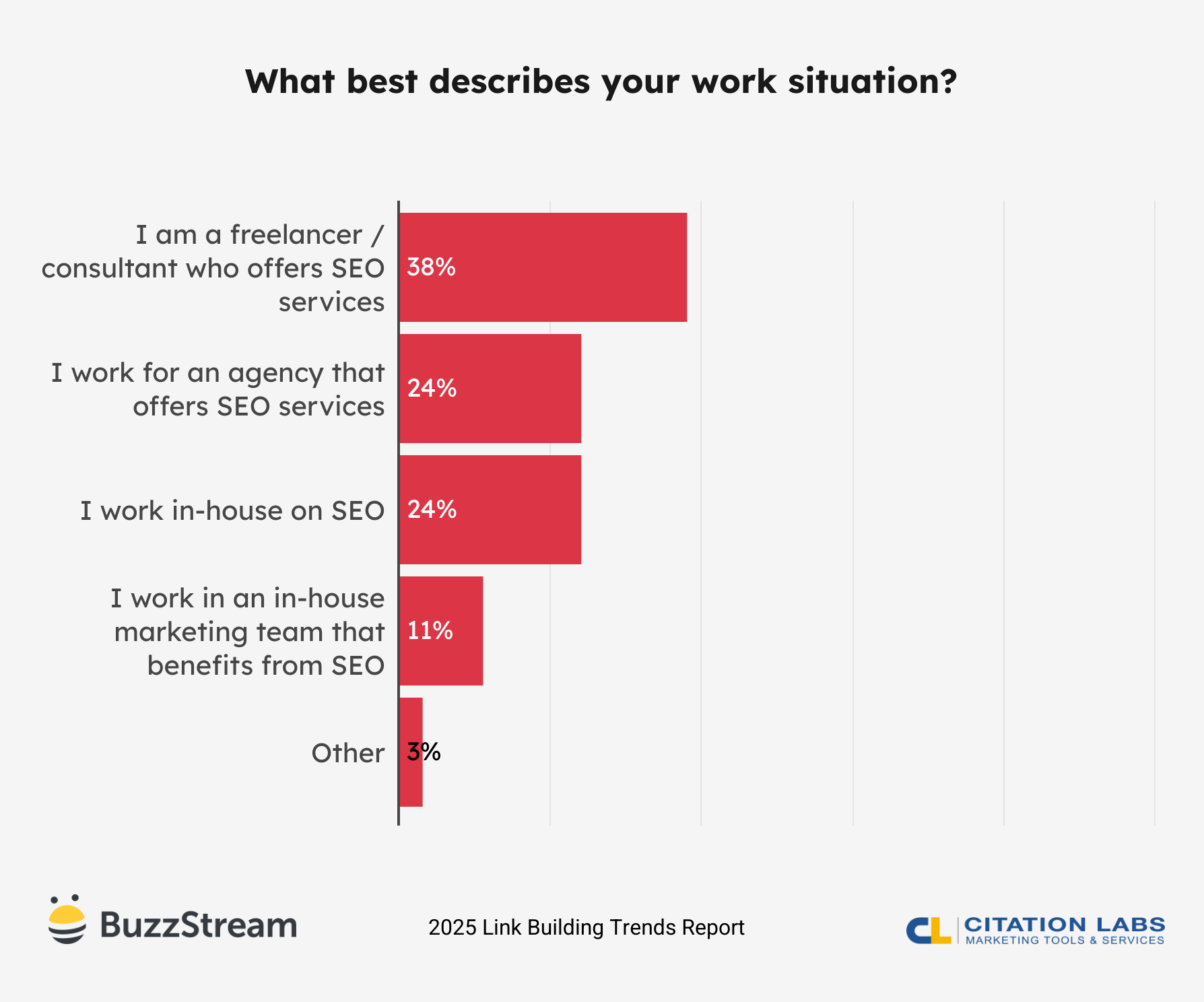
The biggest group of respondents in our study are freelancers/consultants (38%). The rest is a mix of agency and in-house.
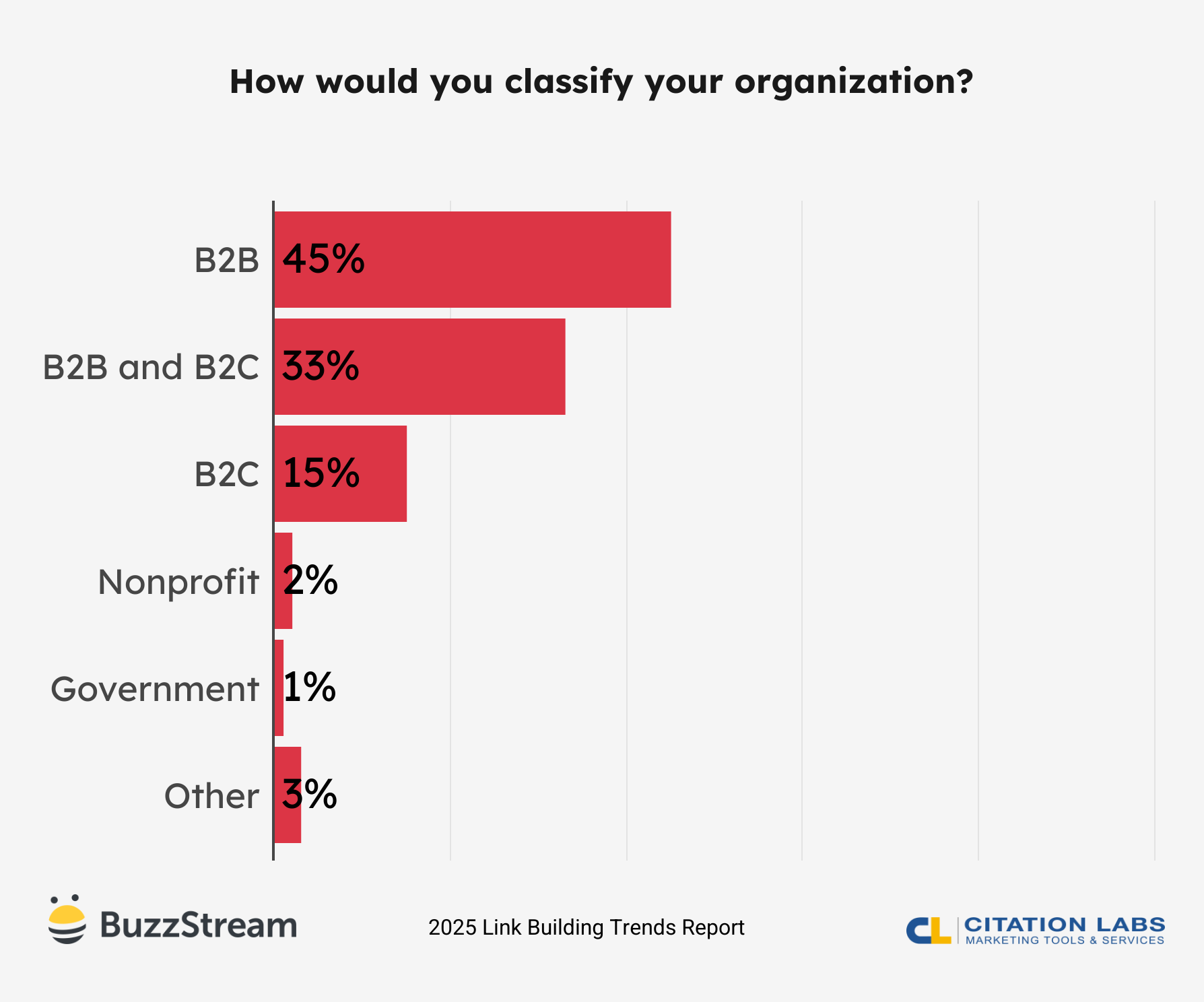
Just about half of the respondents (45%) in the survey are in B2B. About a third are in both B2B and B2C.
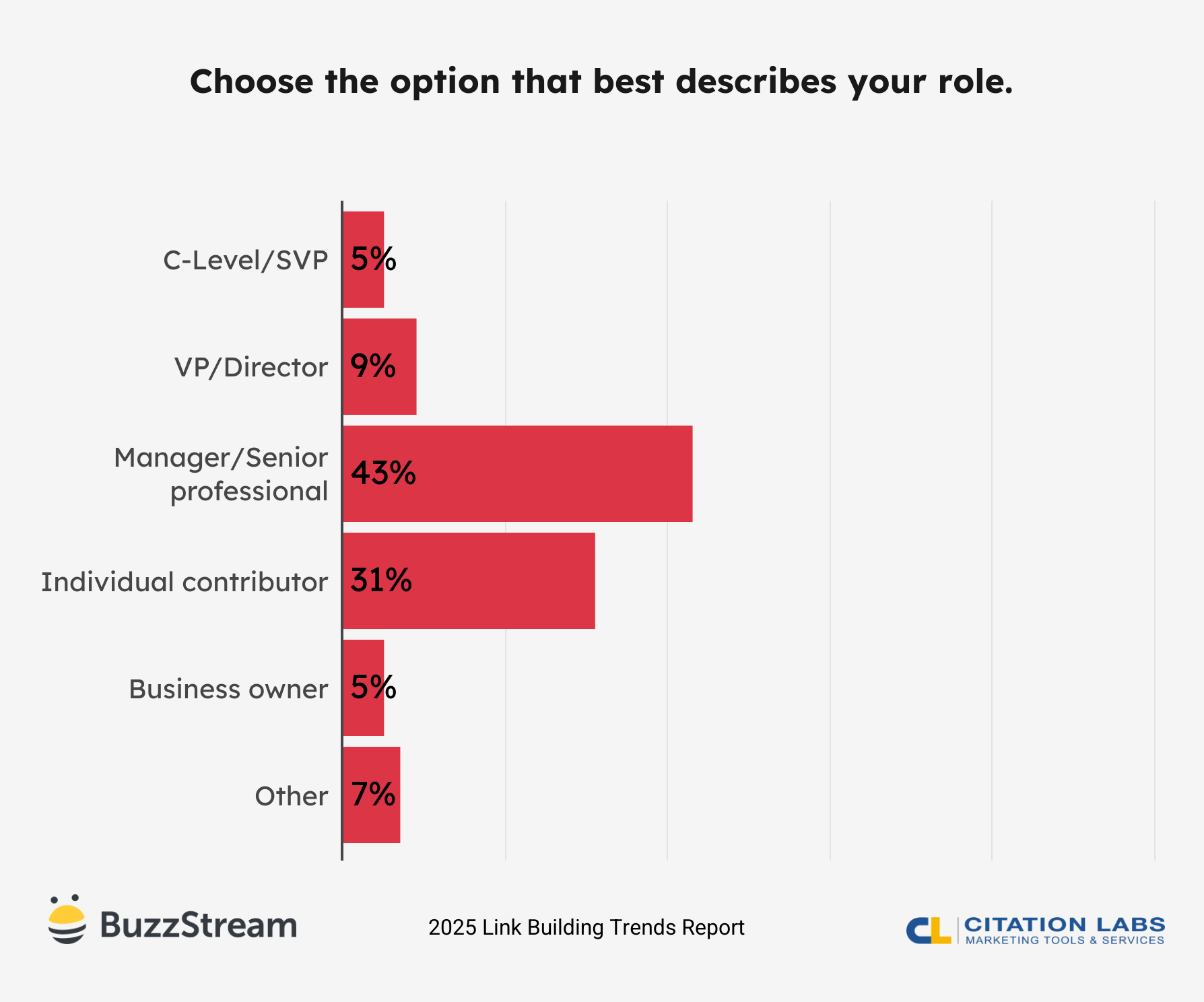
Just under half (43%) of our responses came from Managers/Senior professionals.
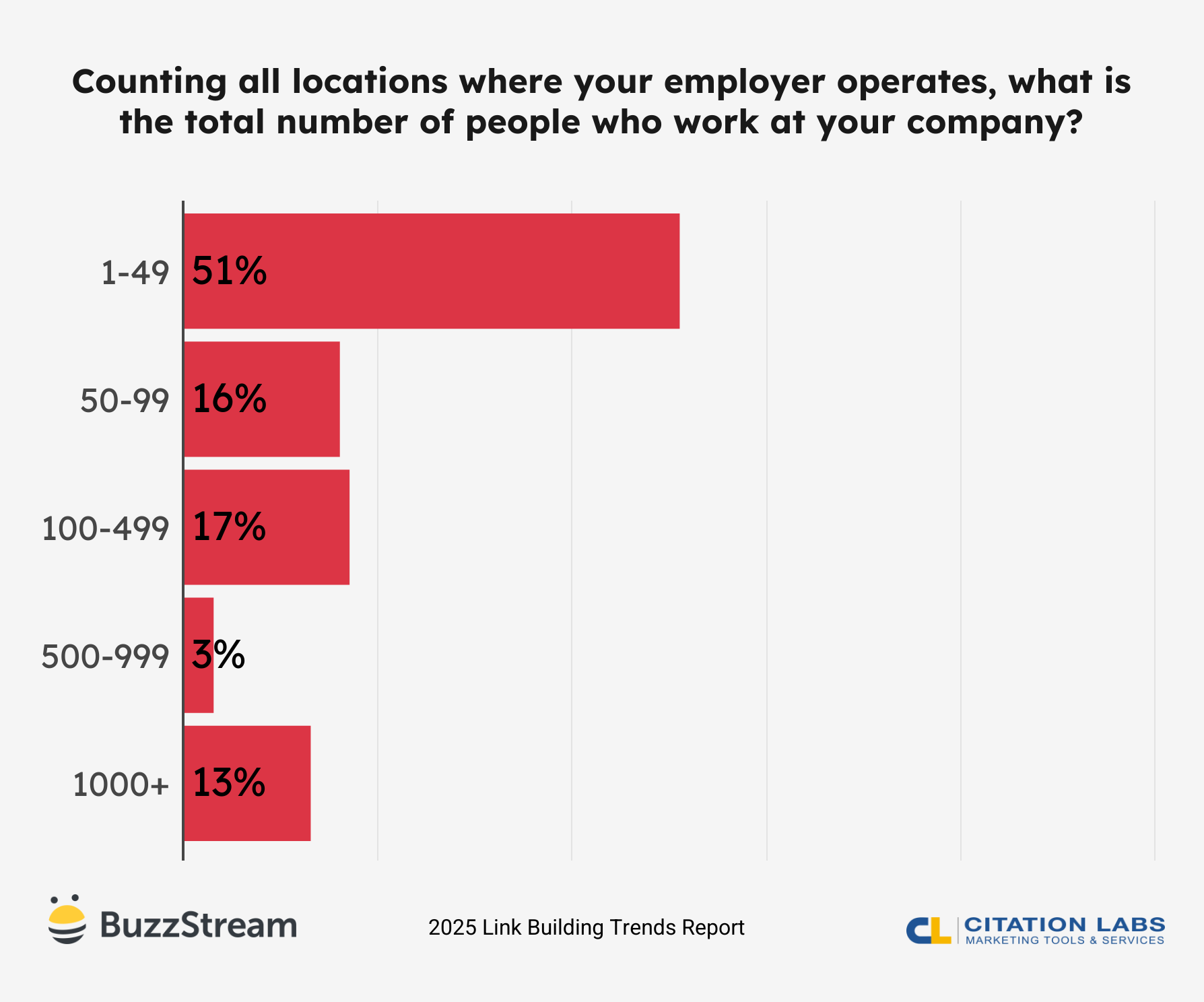
About half of our respondents (51%) have 1-49 people at their company.
Section 9
Thank You Contributors
On behalf of the Citation Labs and BuzzStream teams, I want to thank everyone who completed the survey.
We literally could not have done it without you!
A special thanks to our expert panel of contributors:
- Ross Simmonds, Foundation Marketing
- James Brockbank, Digitaloft
- Kelsey Libert, Fractl
- Darren Kingman, Root Digital
- Bibi The Link Builder, BibiBuzz
- Jack Chambers-Ward, Candour
- Eric Carrell, dofollow.com
- Shaurya Jain, Herculeanseo.com
- Joy Hawkins, Sterling Sky Inc.
- Tom Demers, Measured SEM LLC
- Gyi Tsakalakis, AttorneySync
- Patrick Stox, Ahrefs
- Shai Aharony, Reboot
- Alexandra Tachalova, Digital Olympus
- Garrett French, Citation Labs
- Paul May, BuzzStream
Lastly, I want to give a huge thanks to Michele Linn of Mantis Research for helping collect the data and compile the findings for the report.

 End-to-end outreach workflow
End-to-end outreach workflow



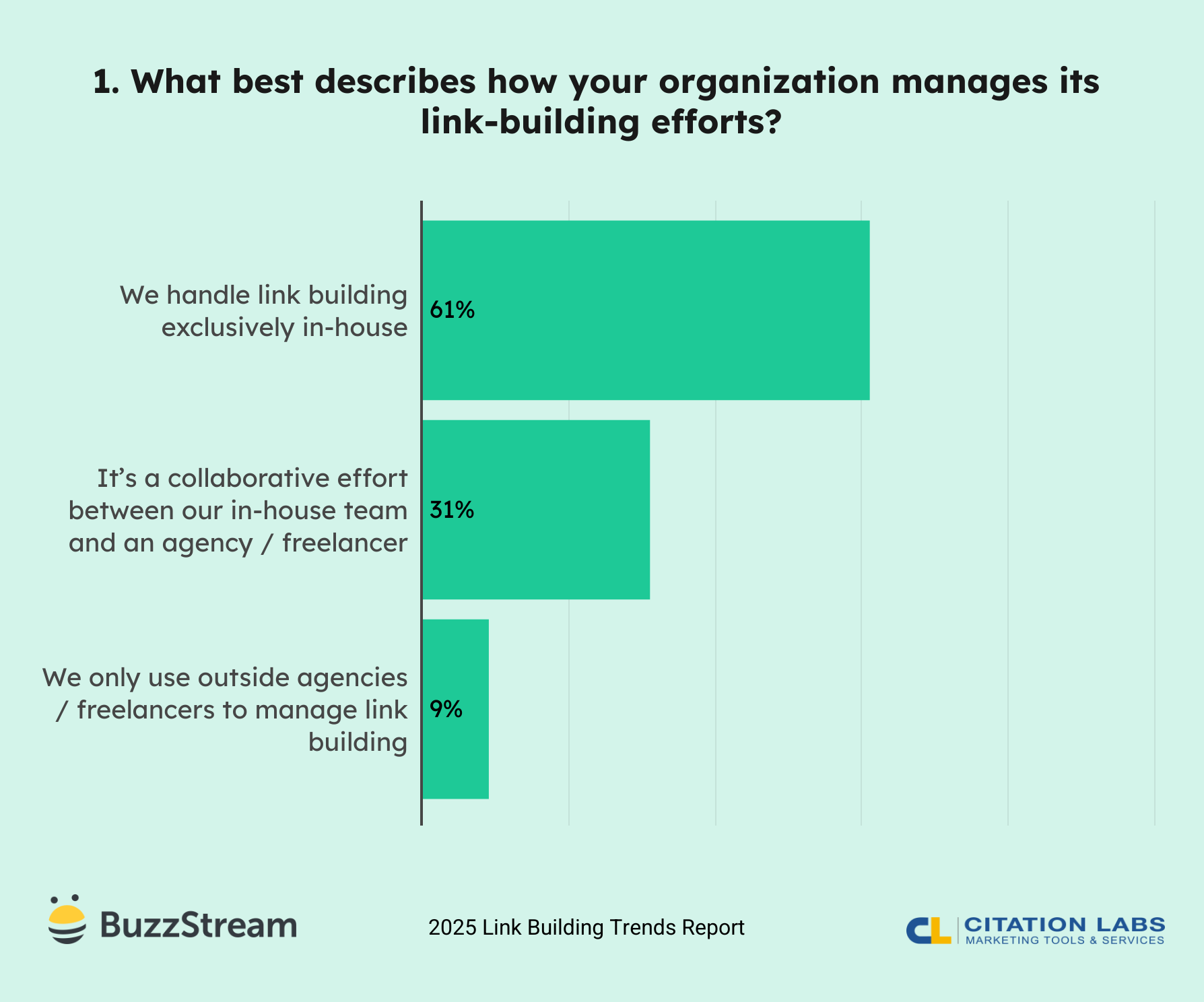
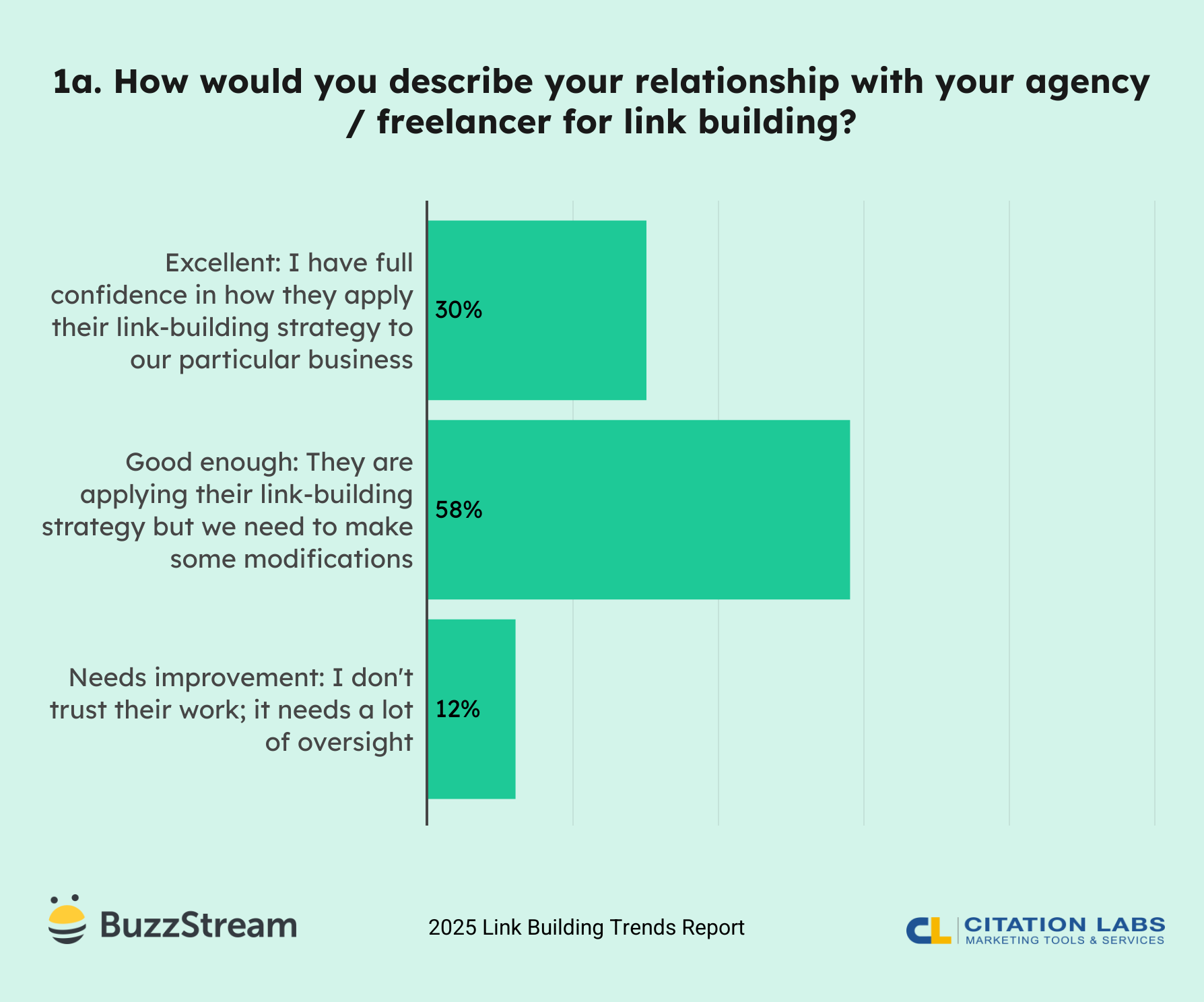
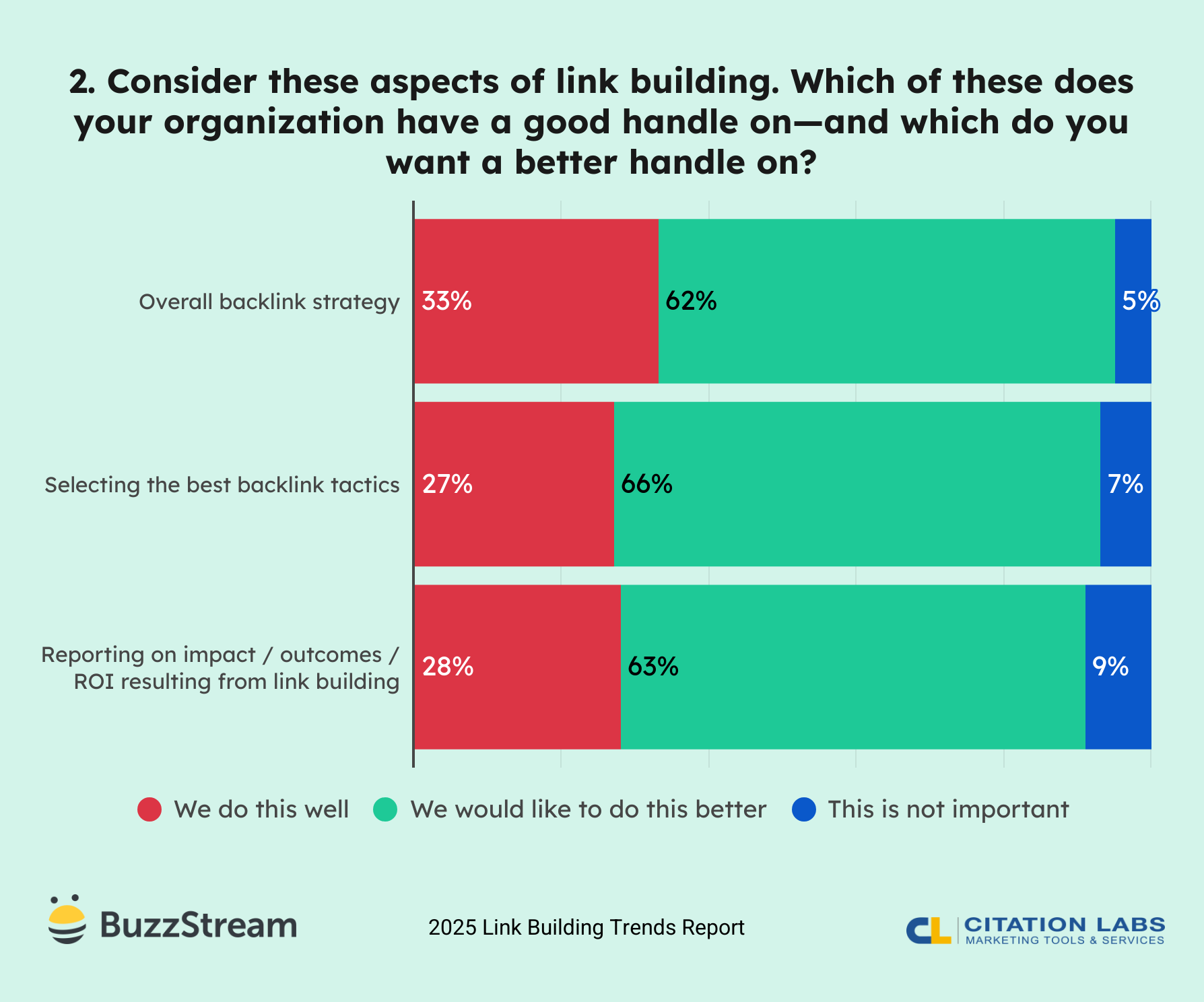
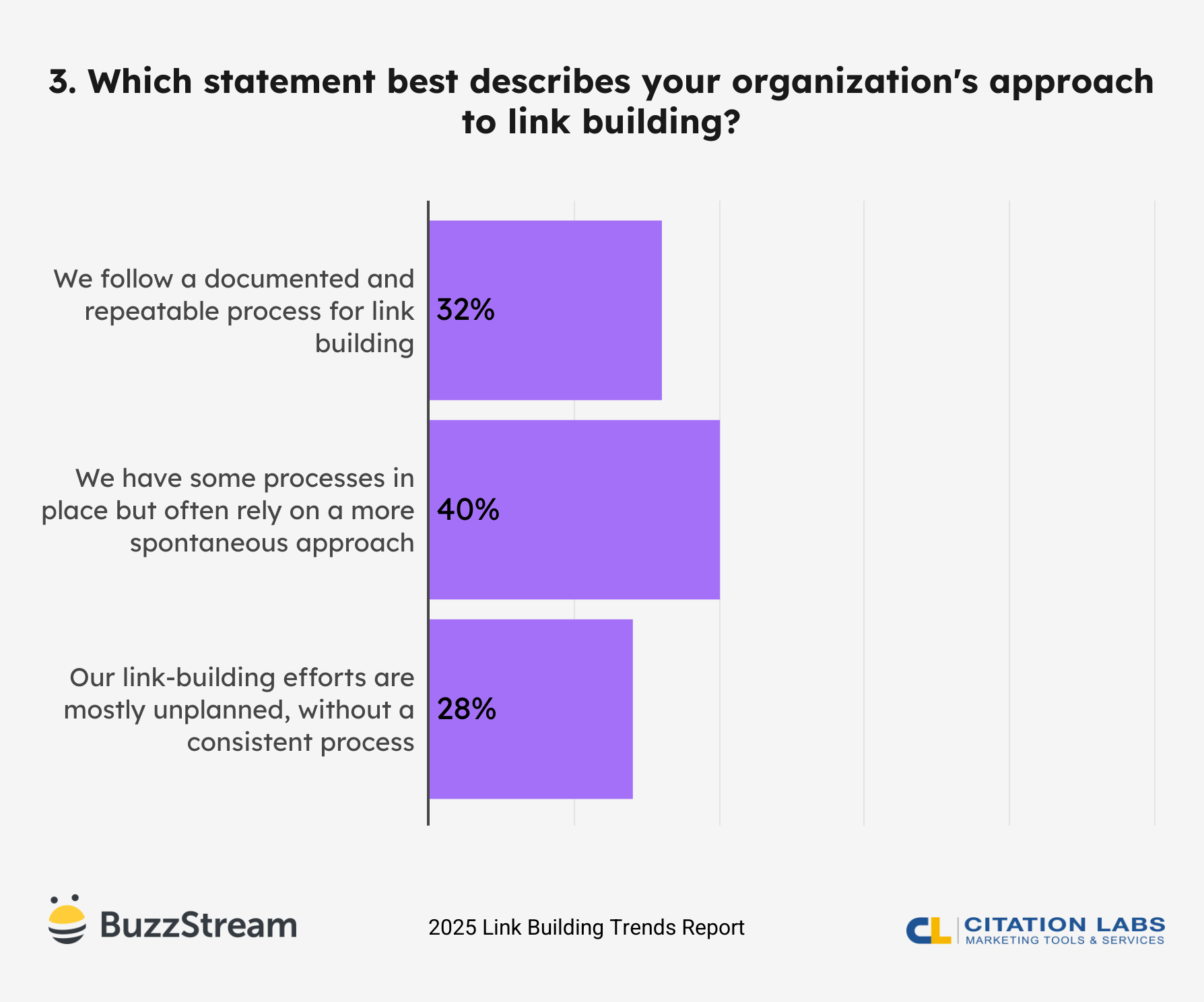
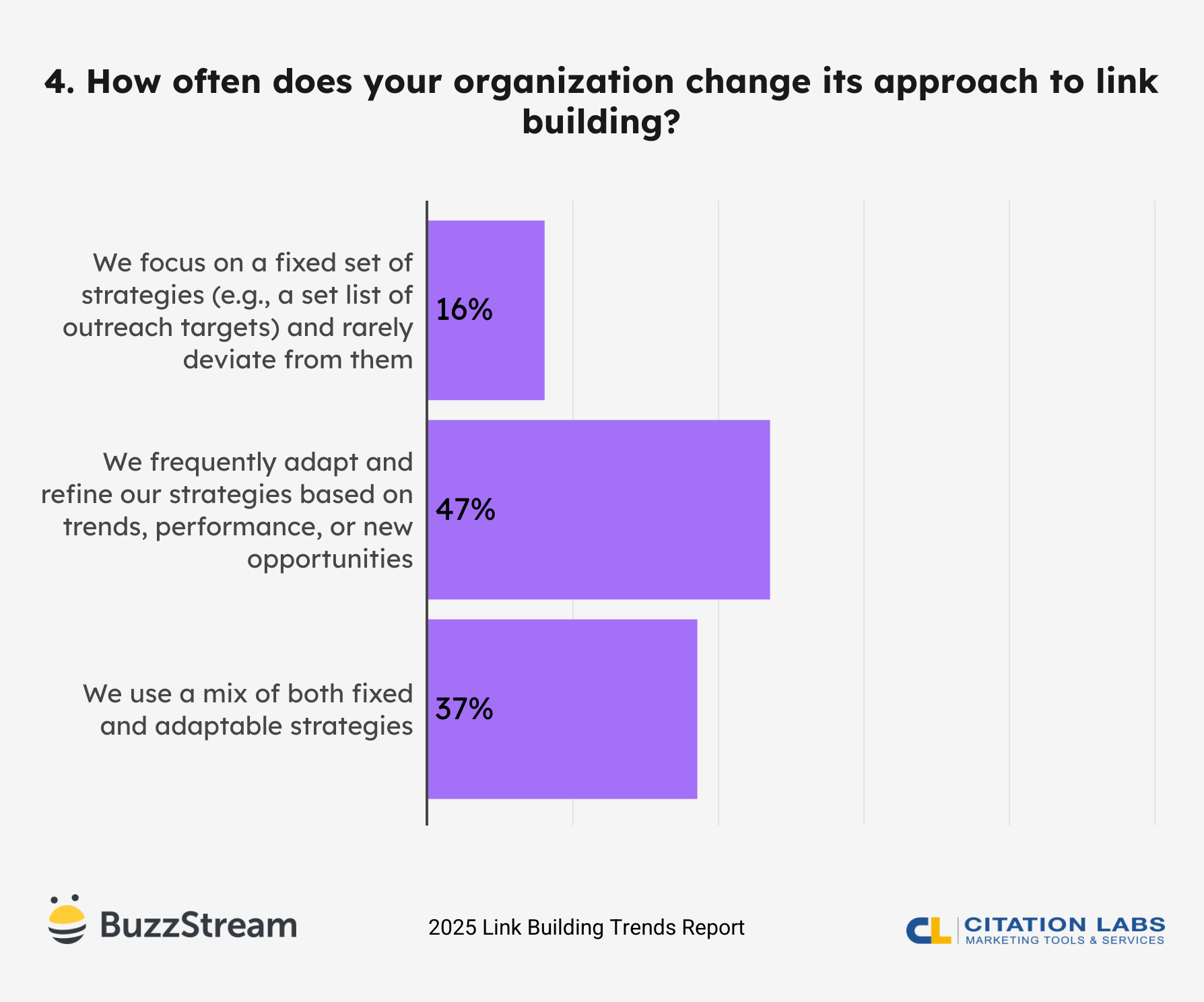
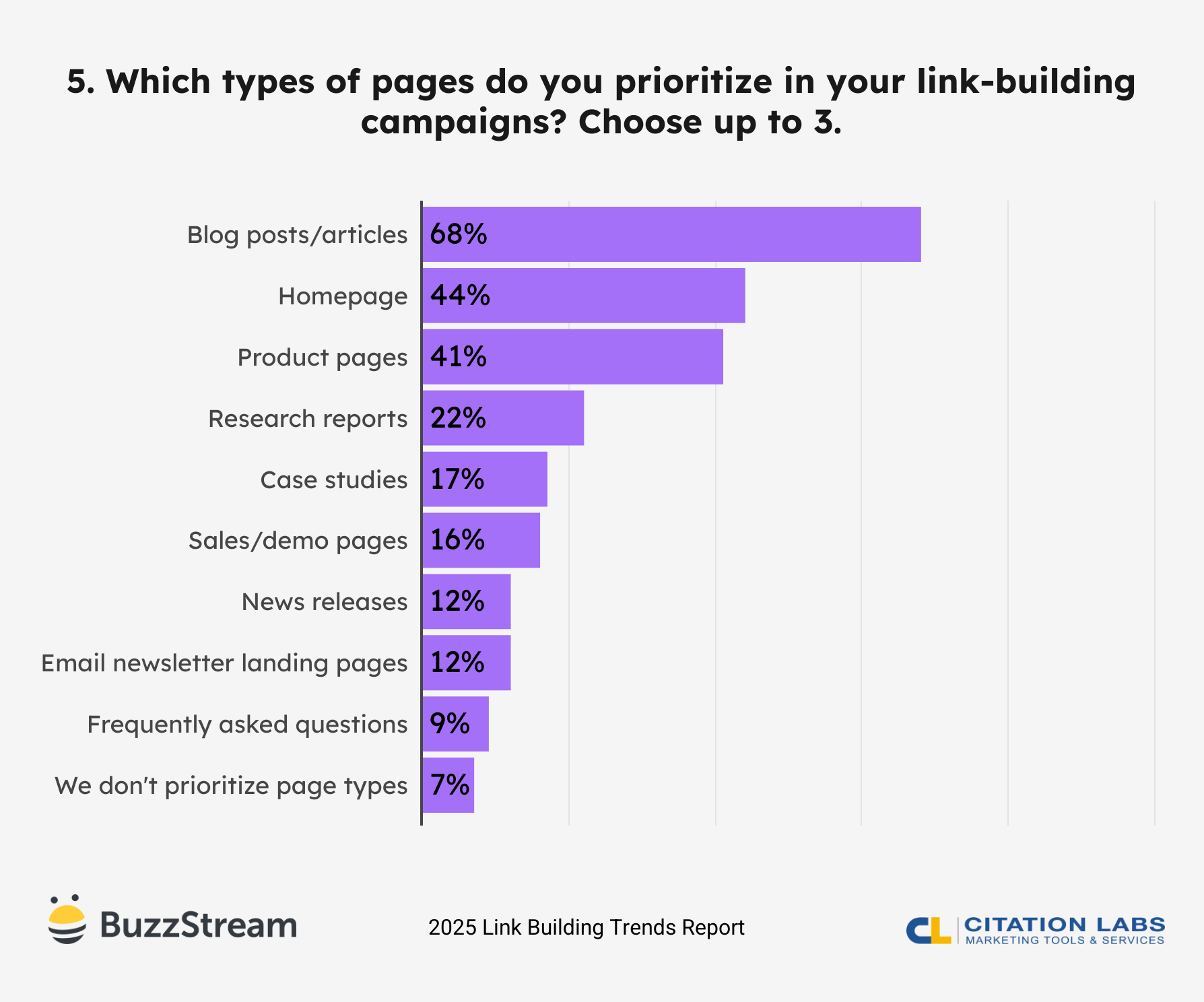
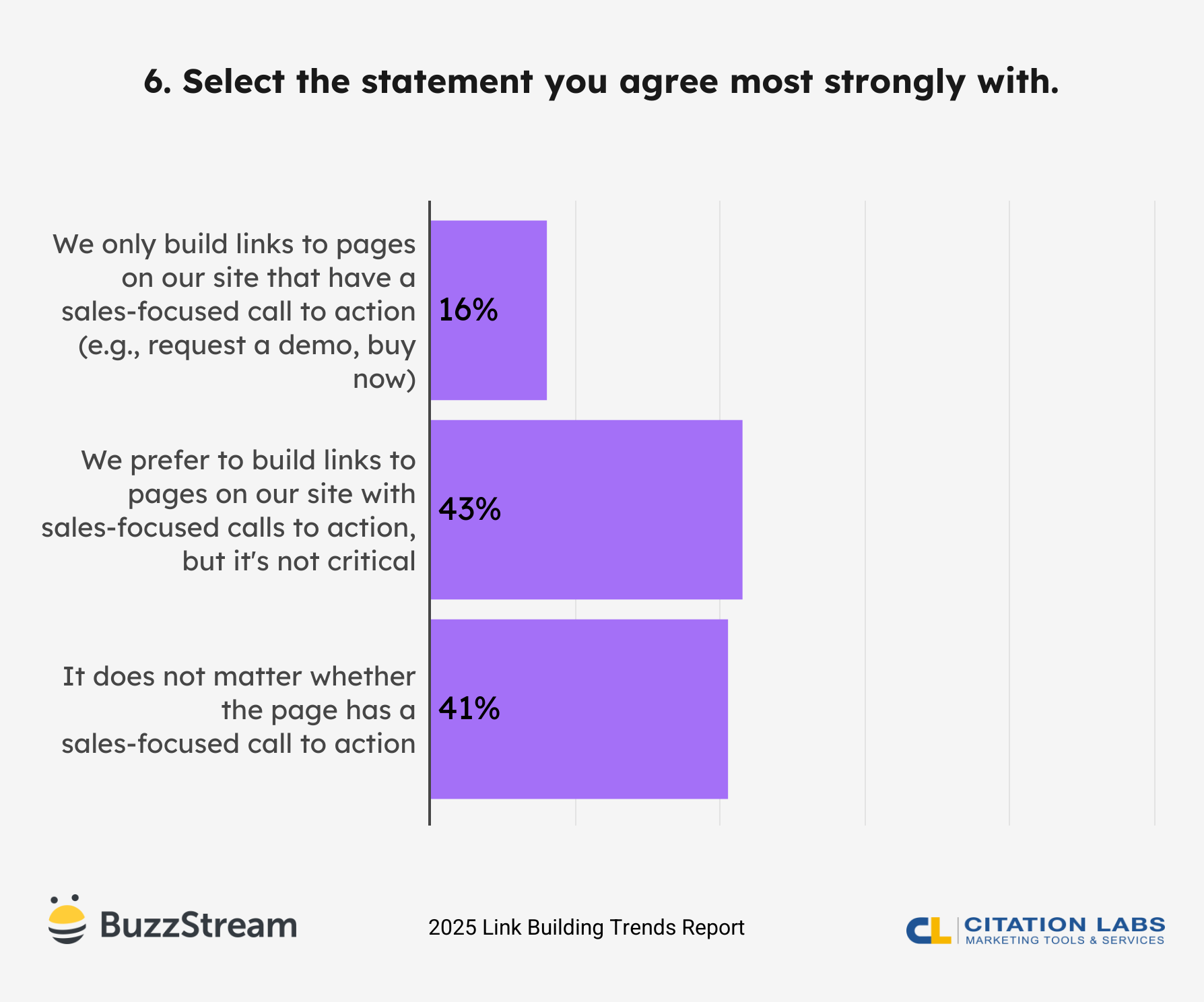
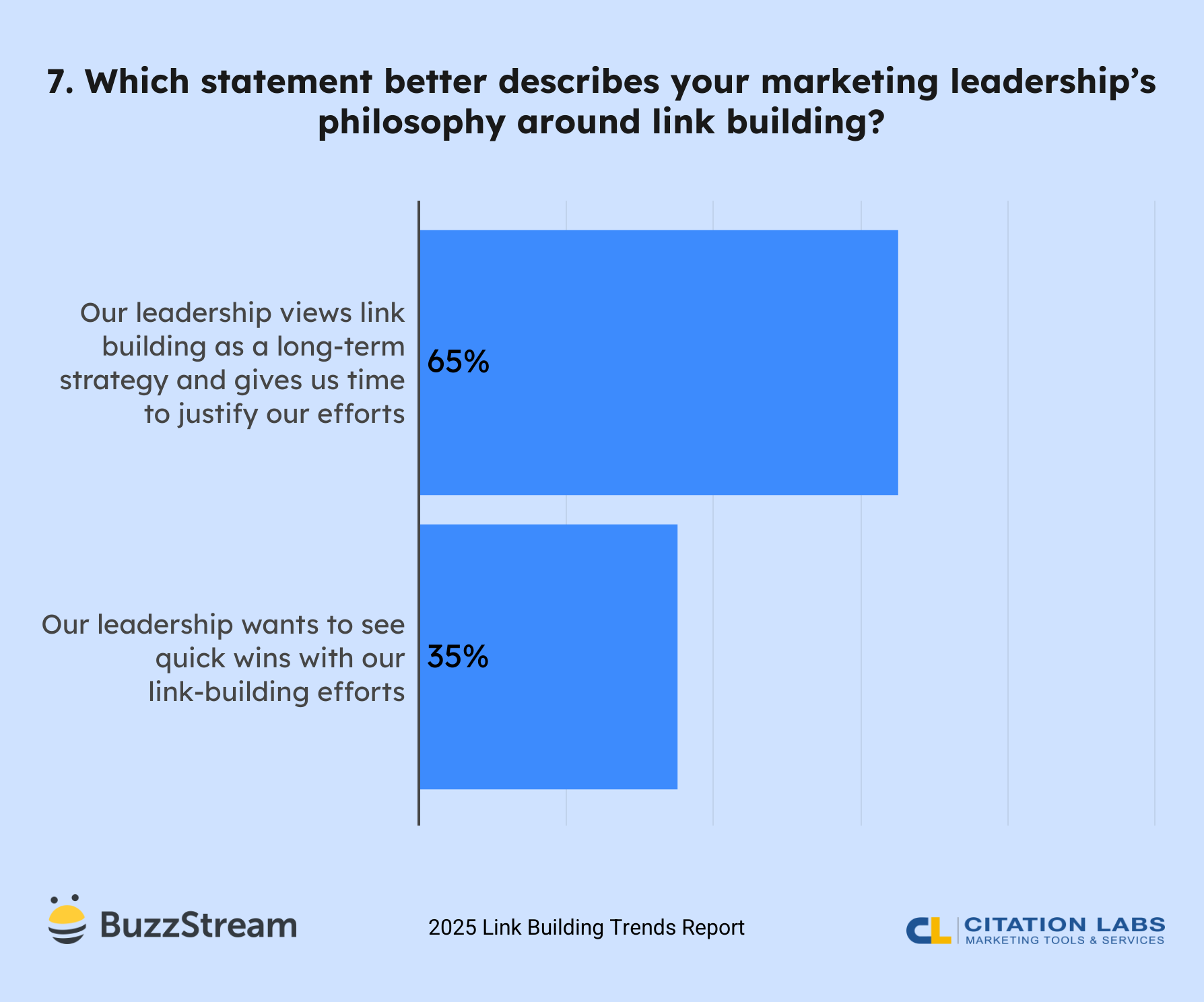
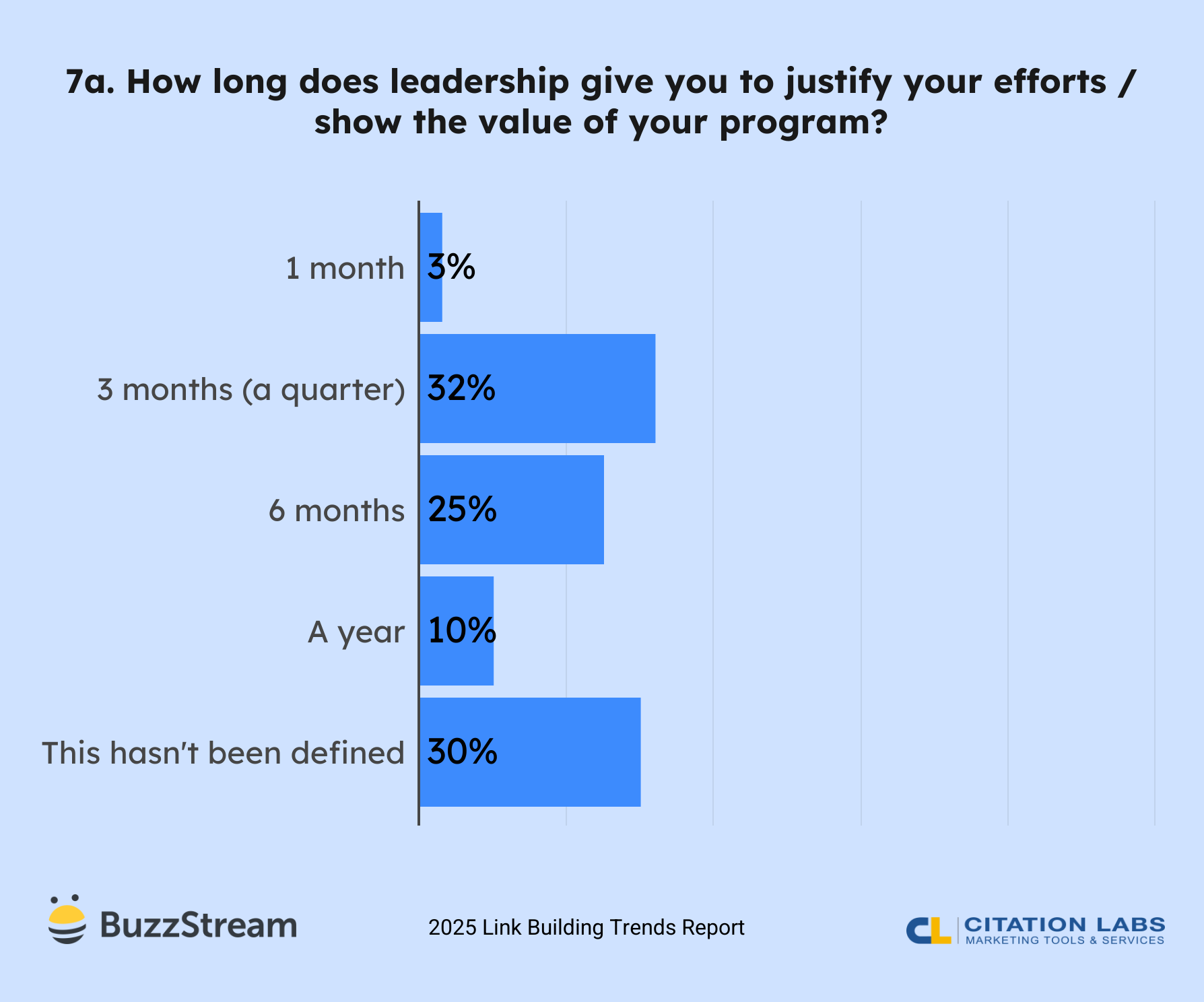
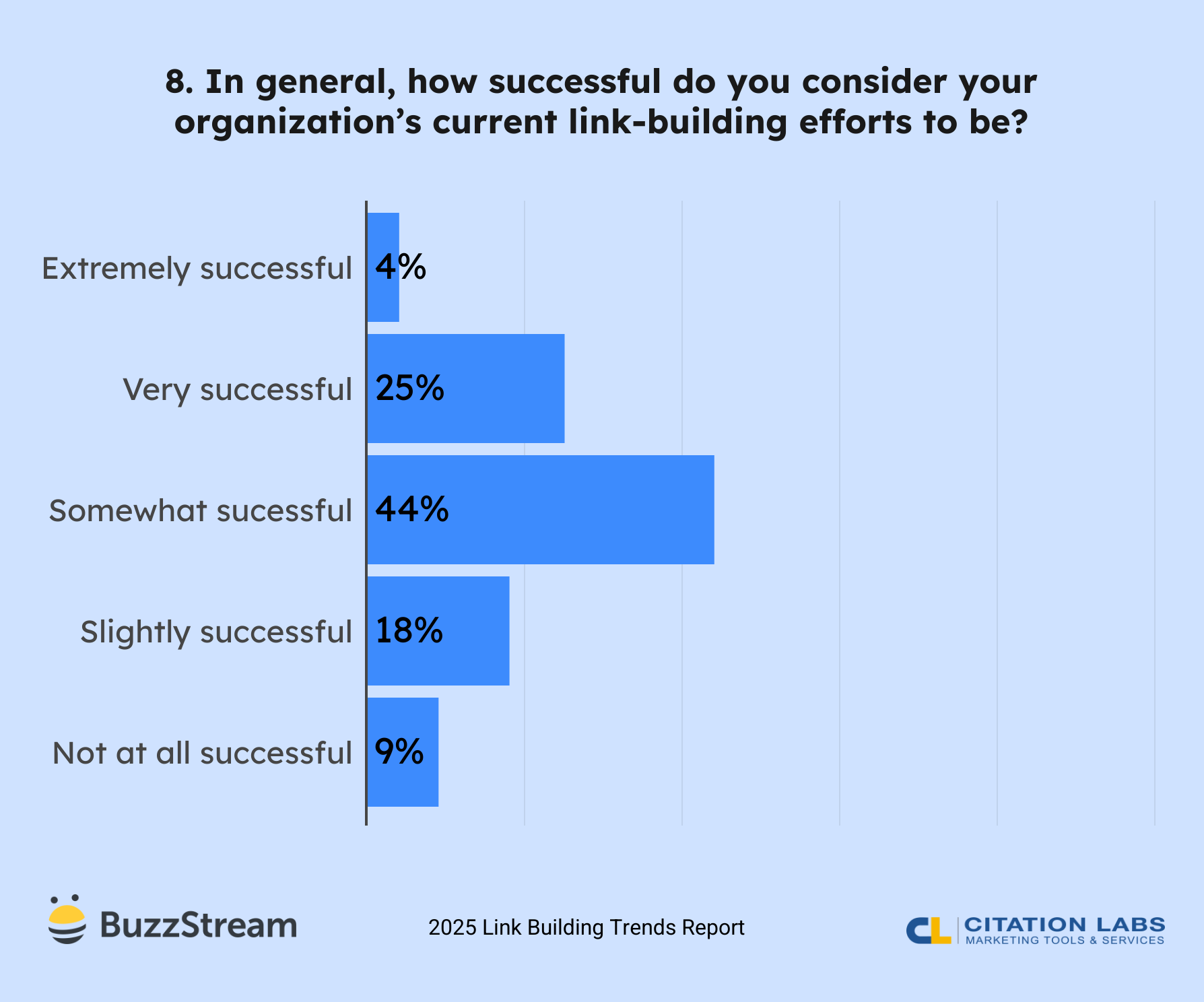
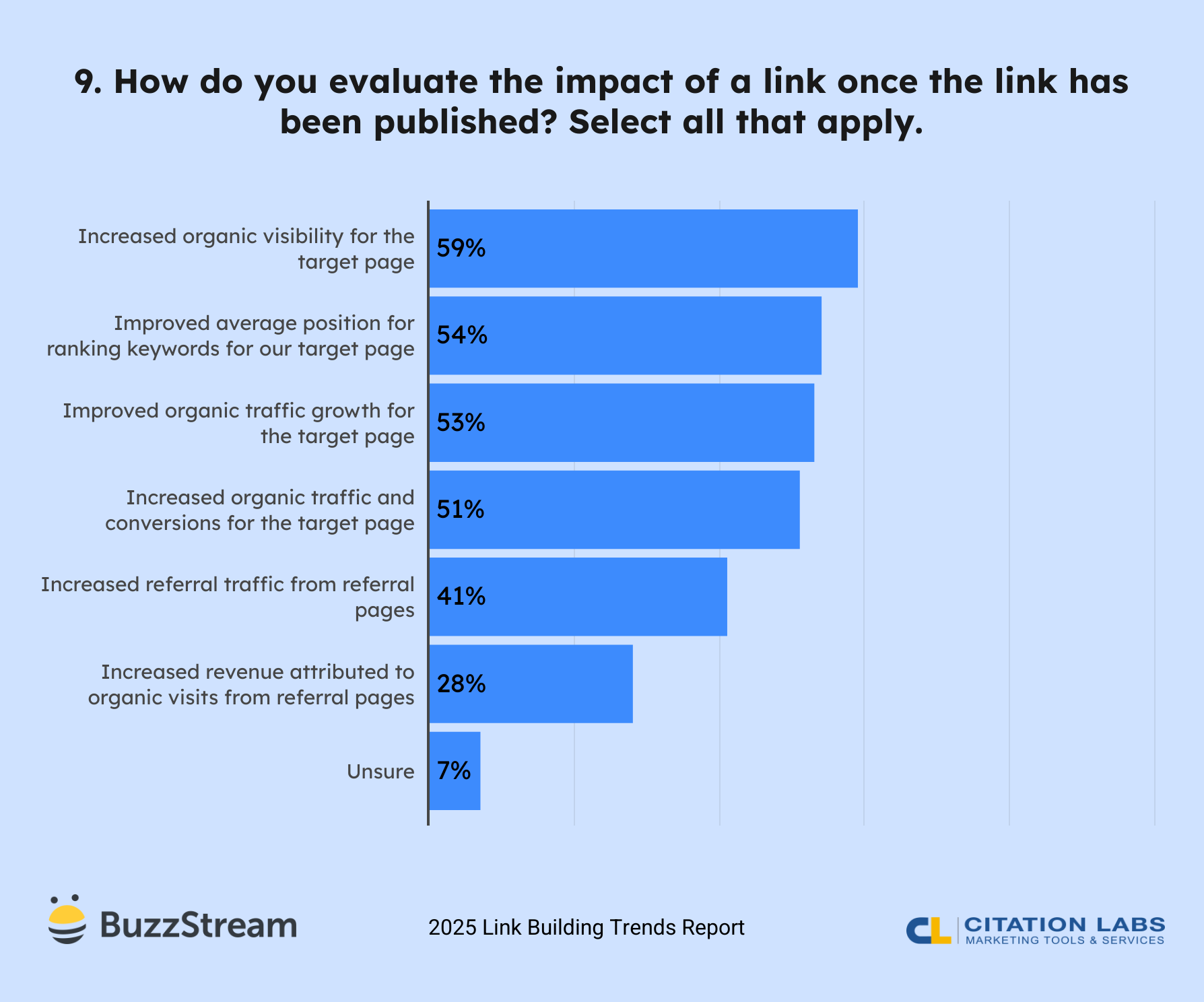
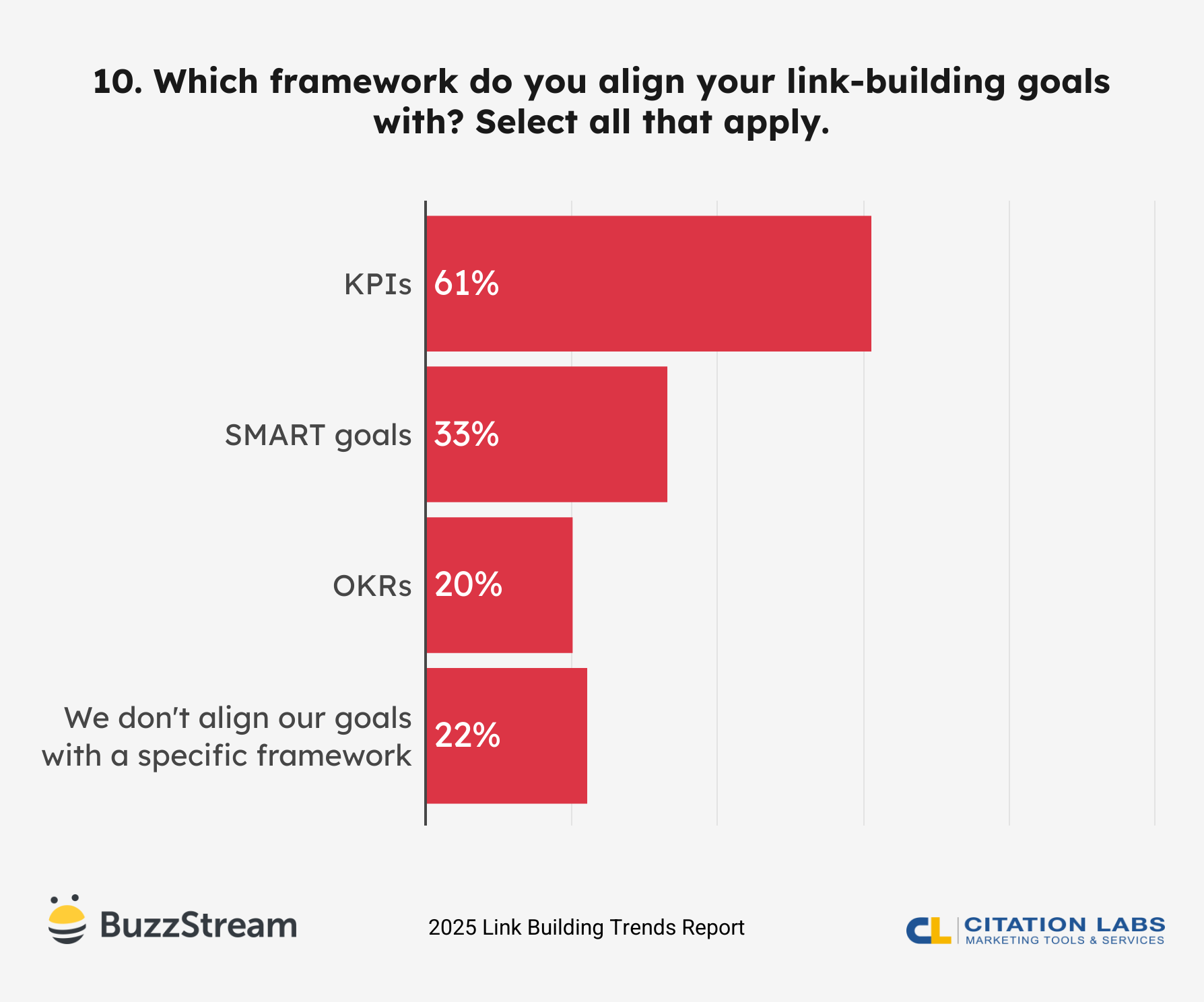
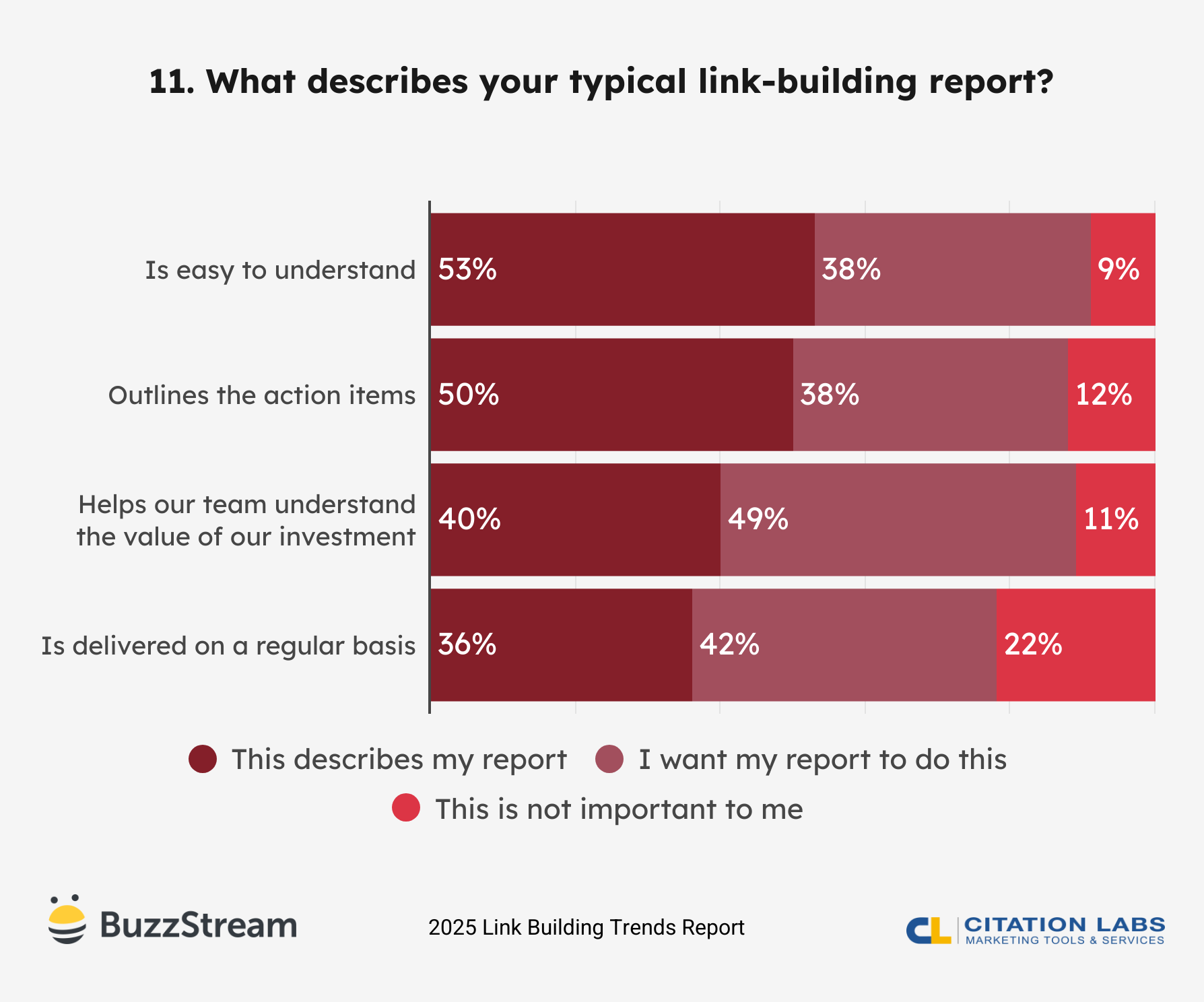
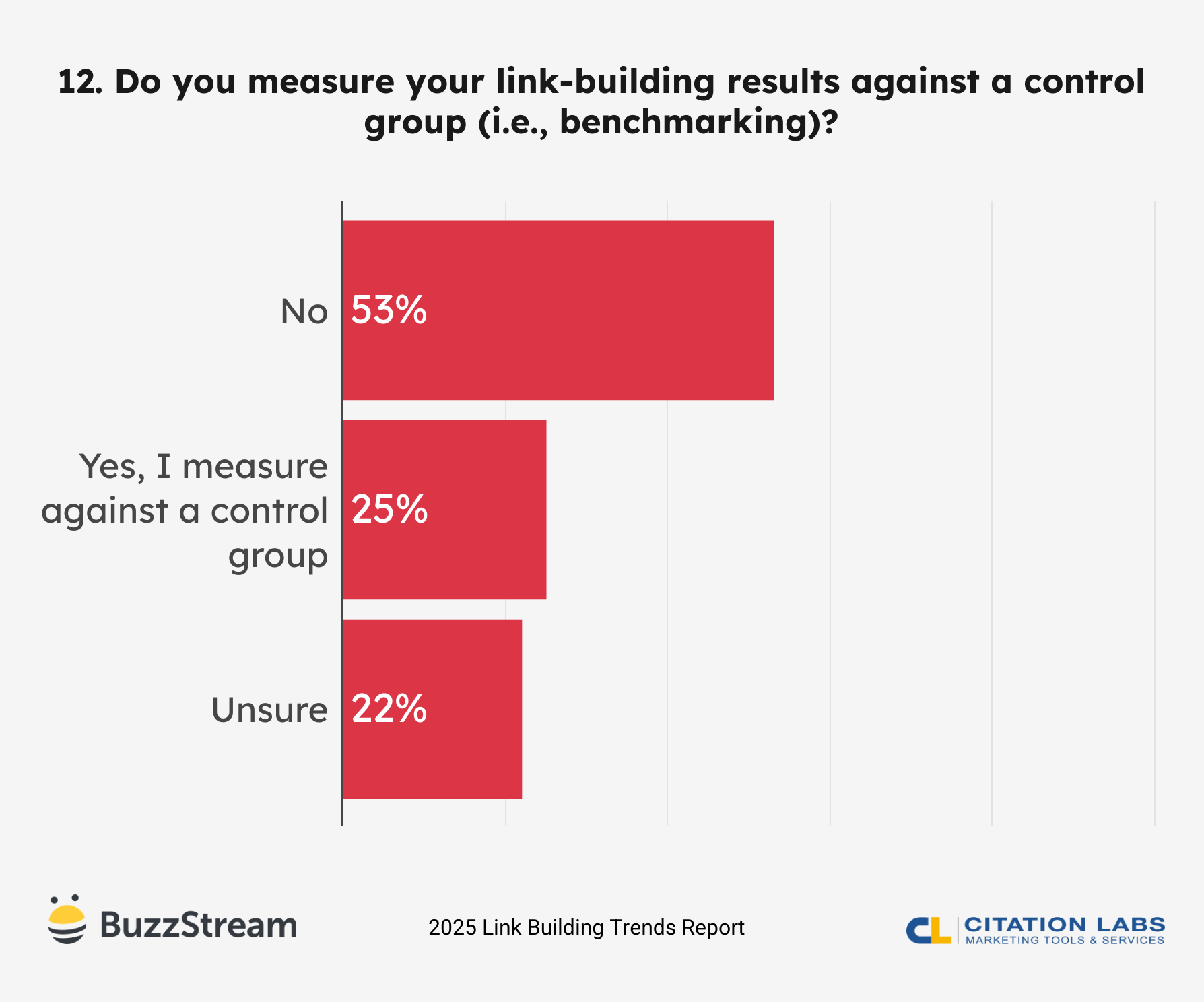
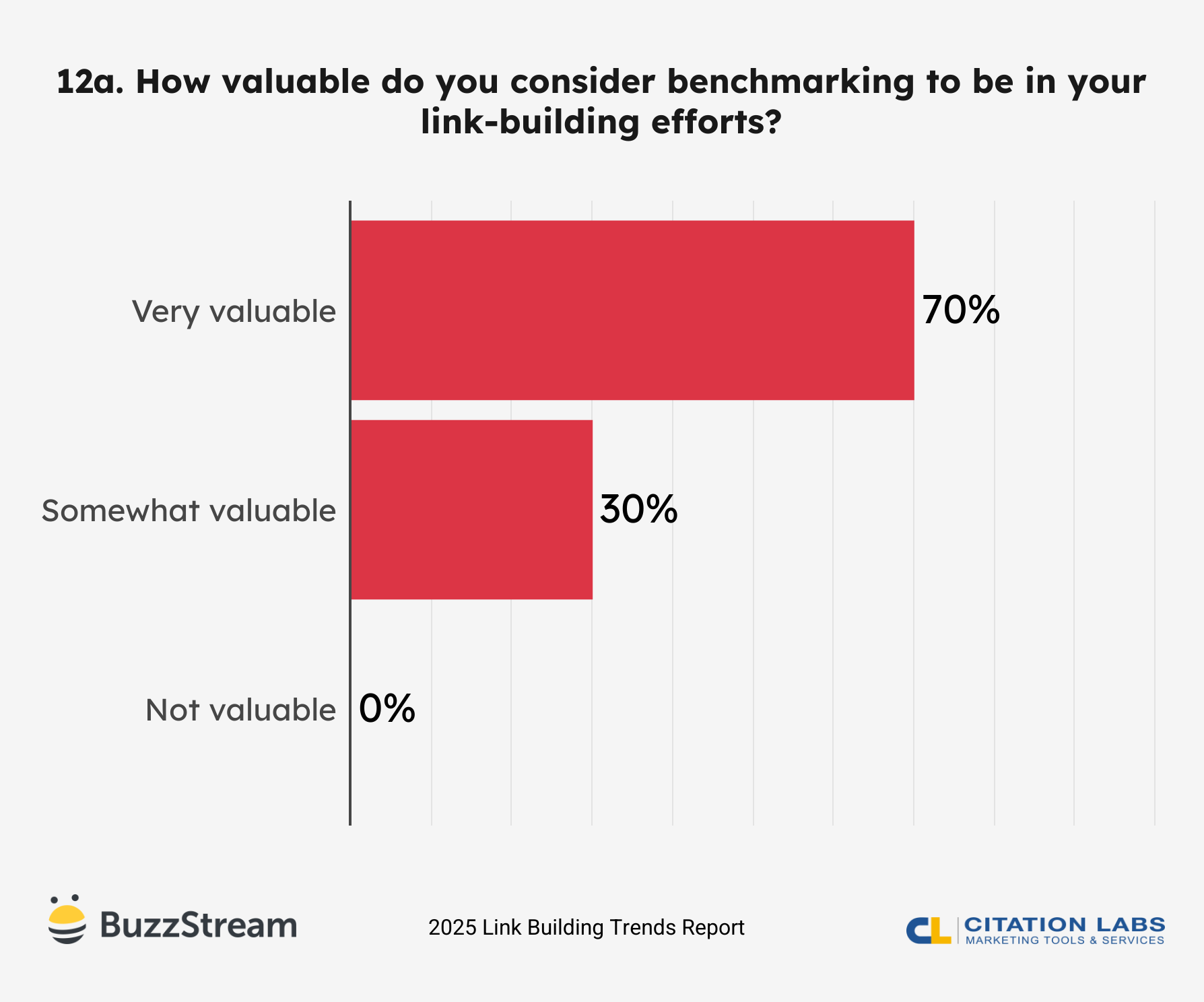
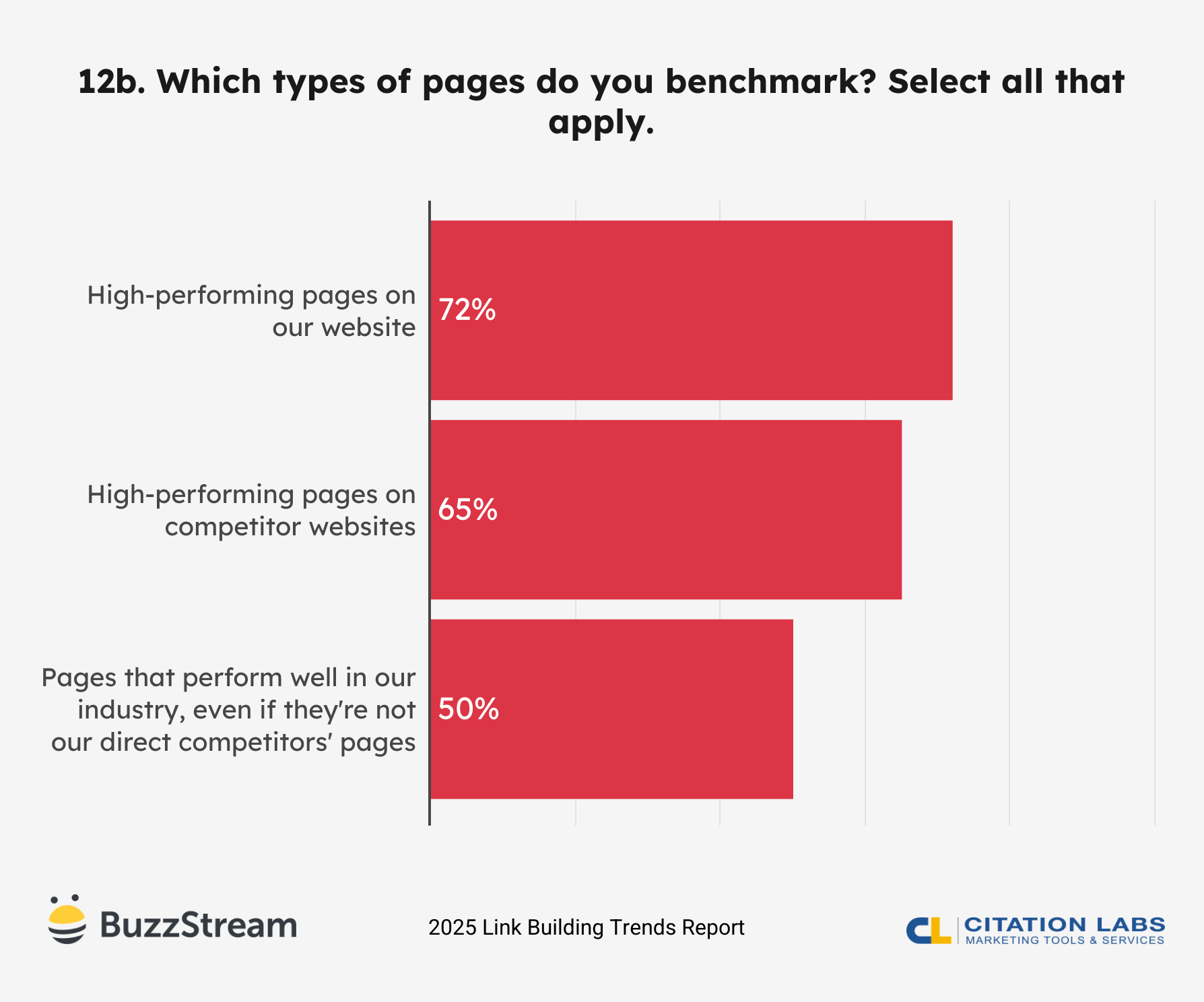
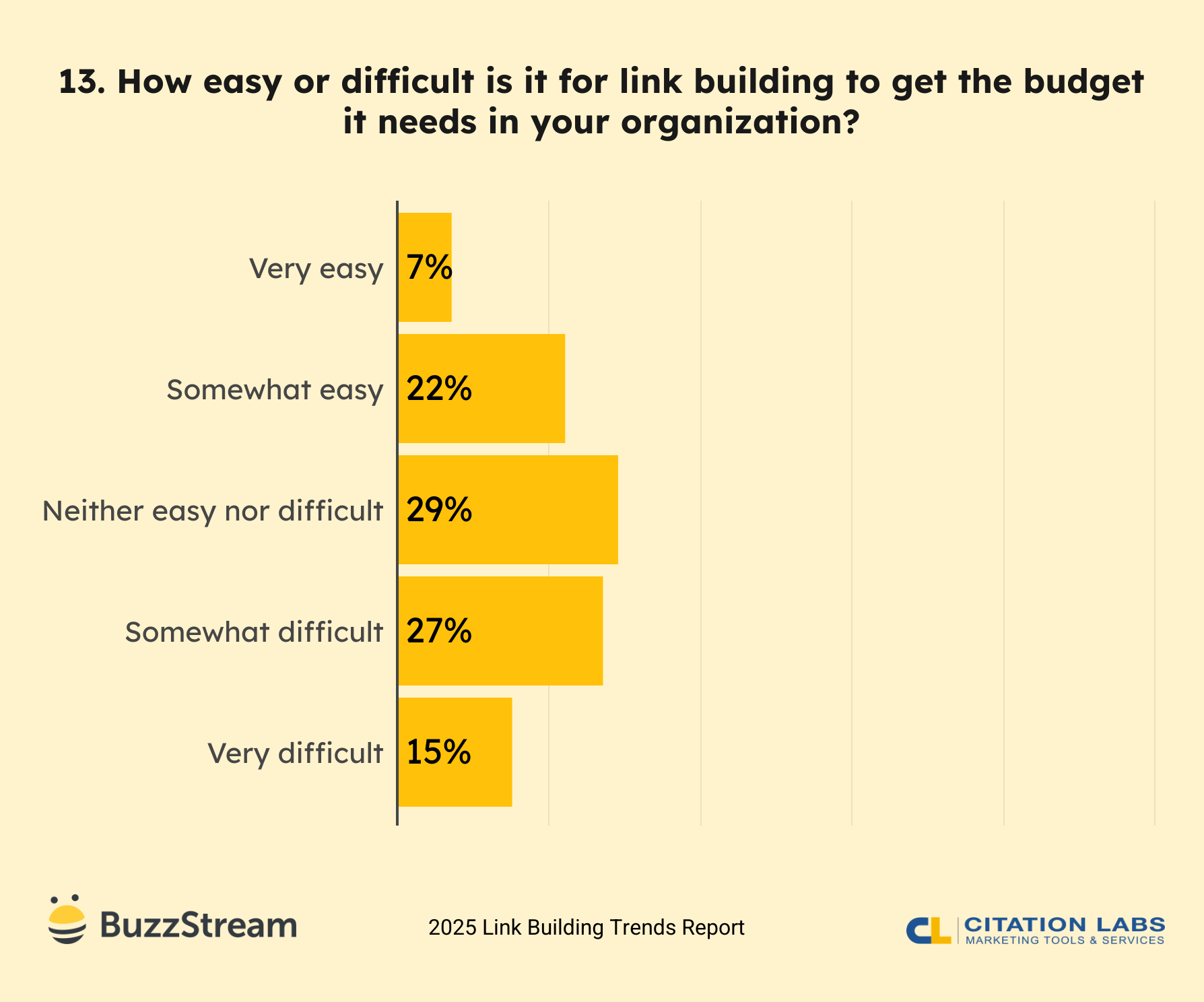
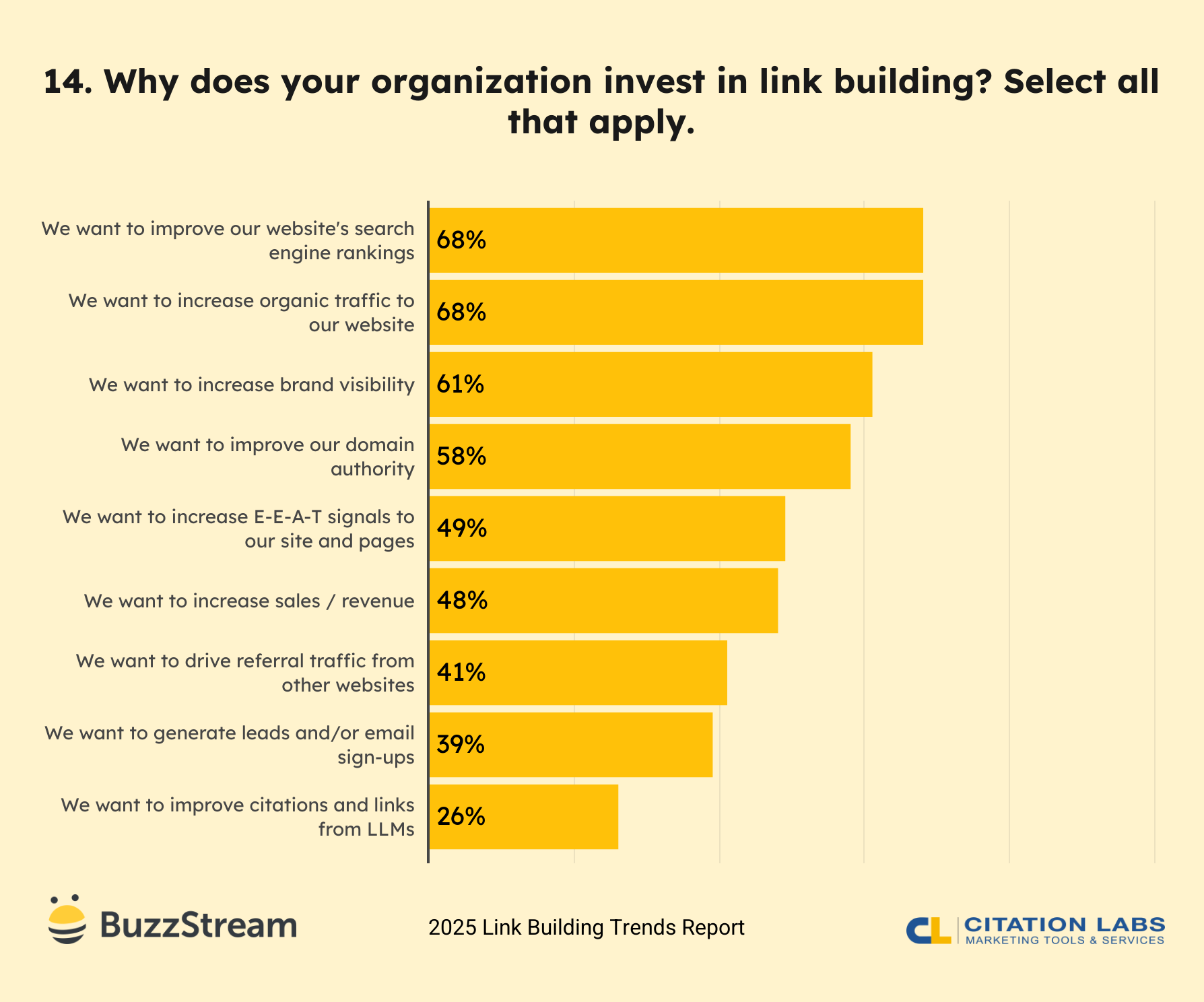
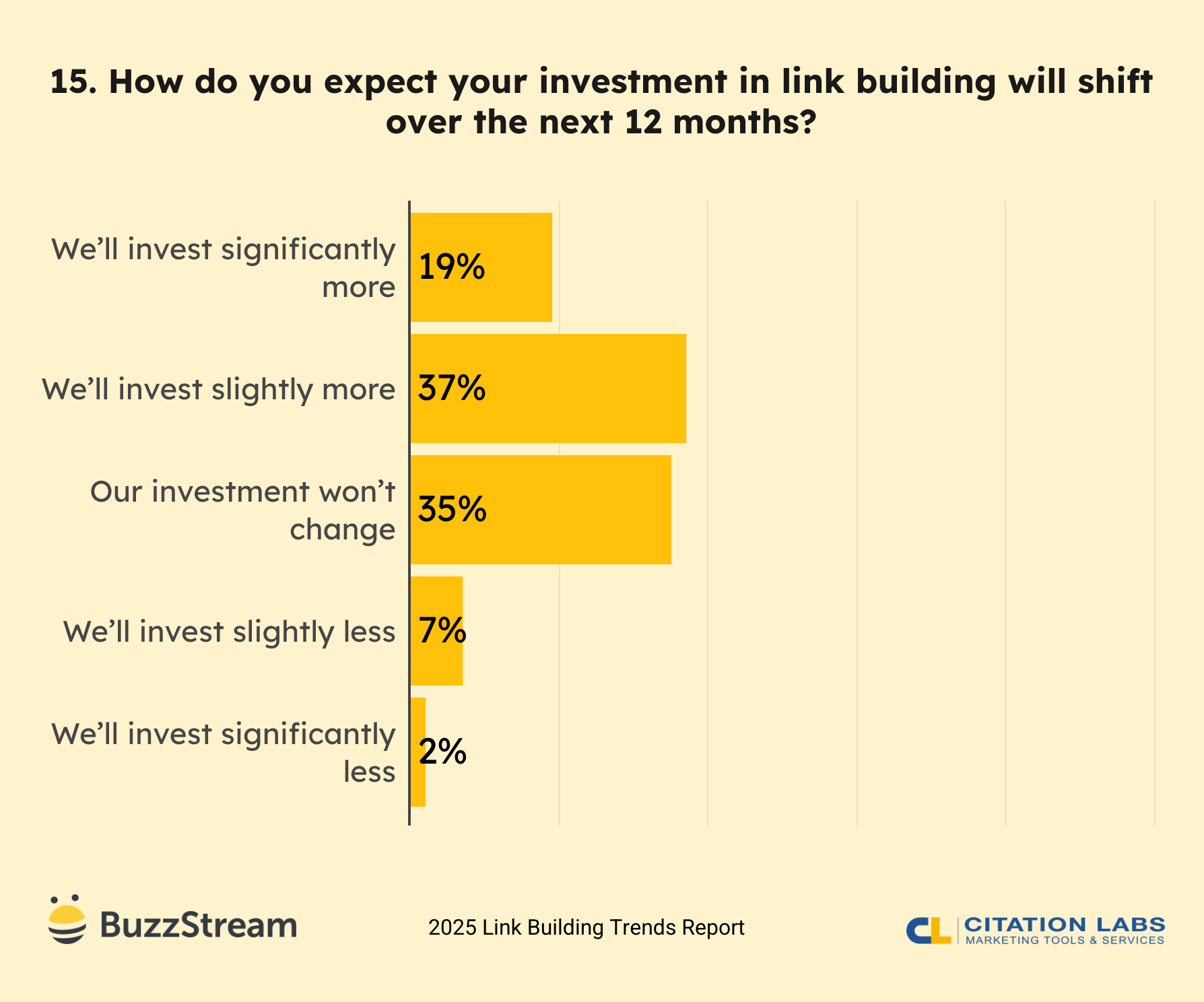
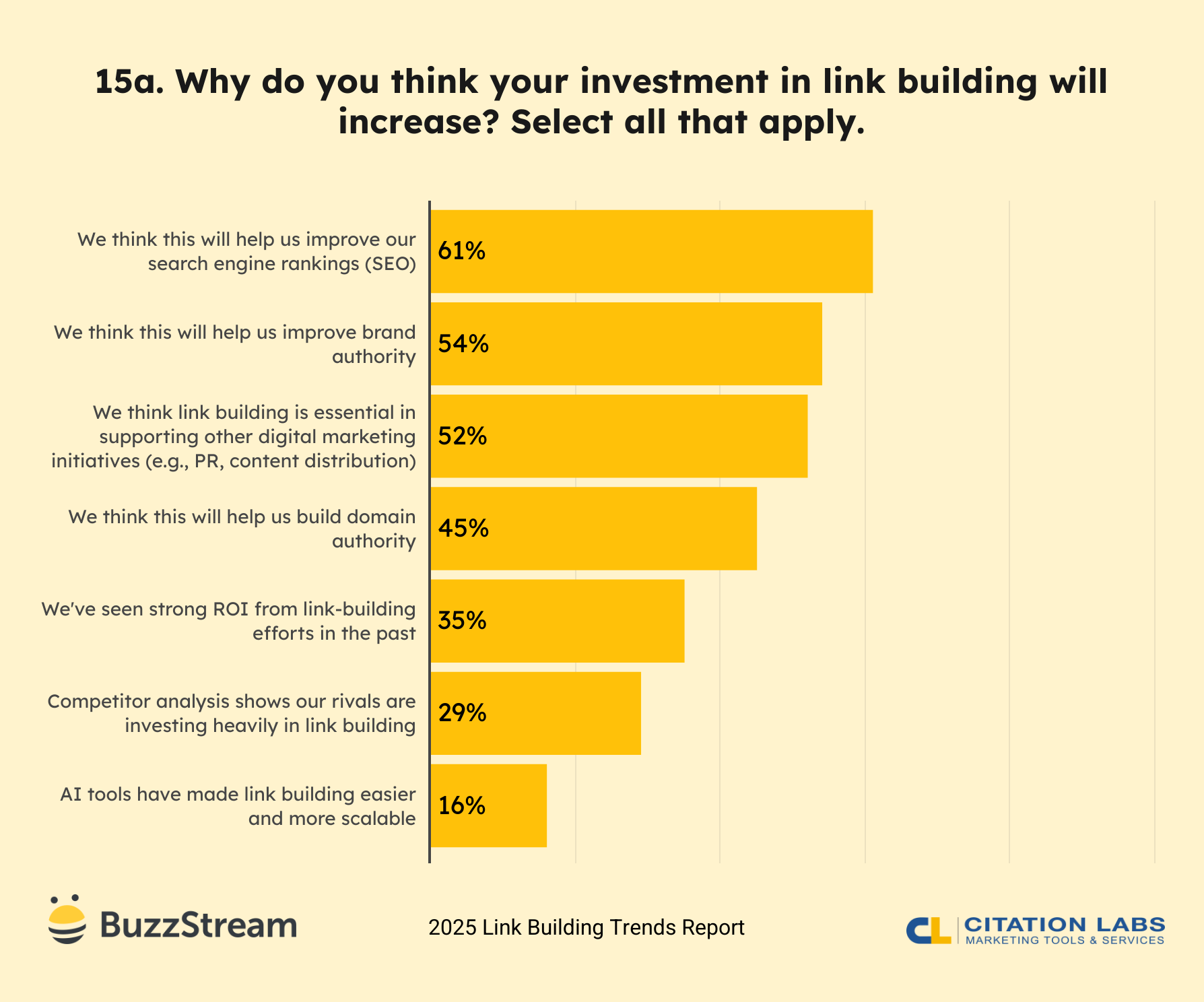
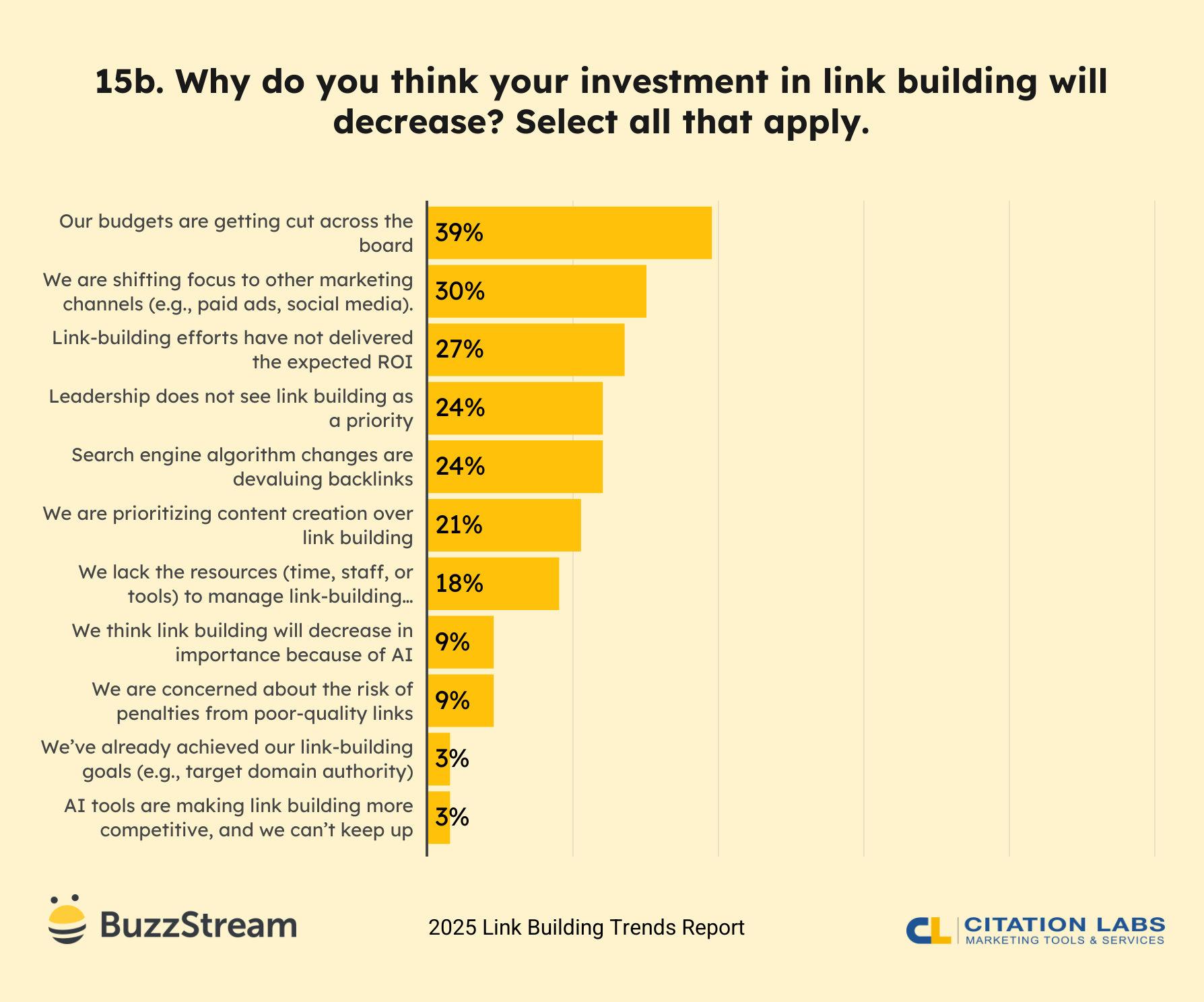
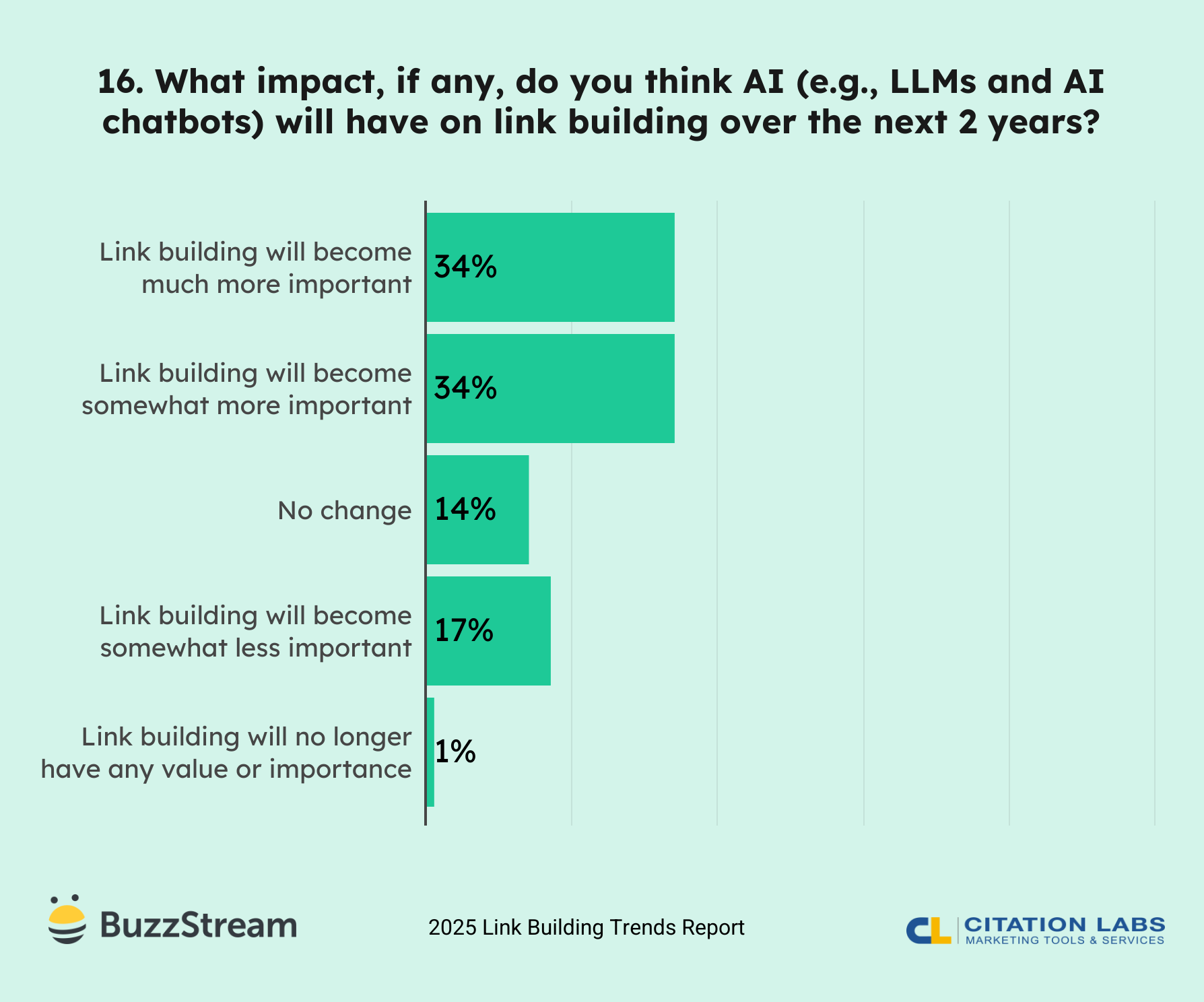
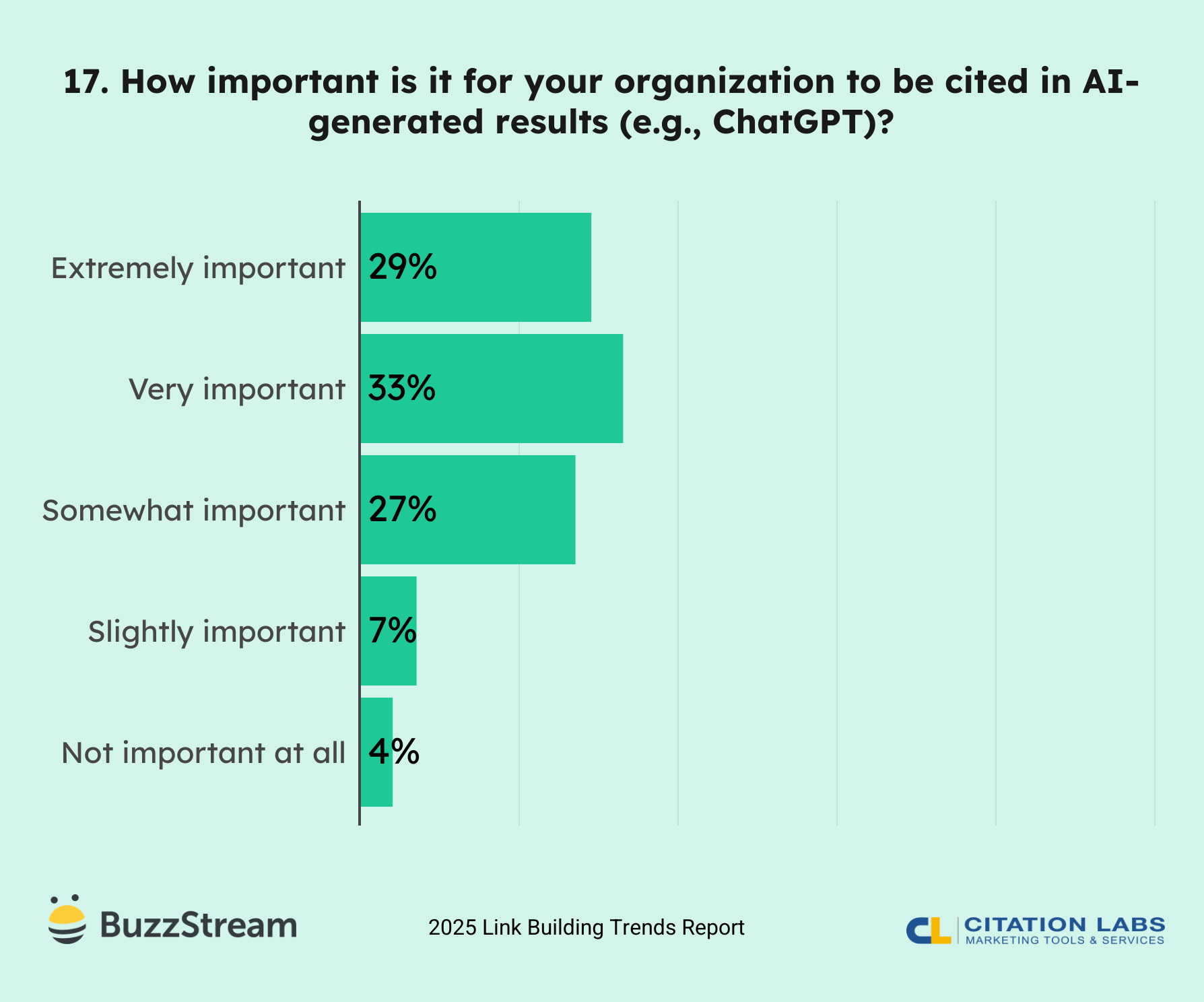
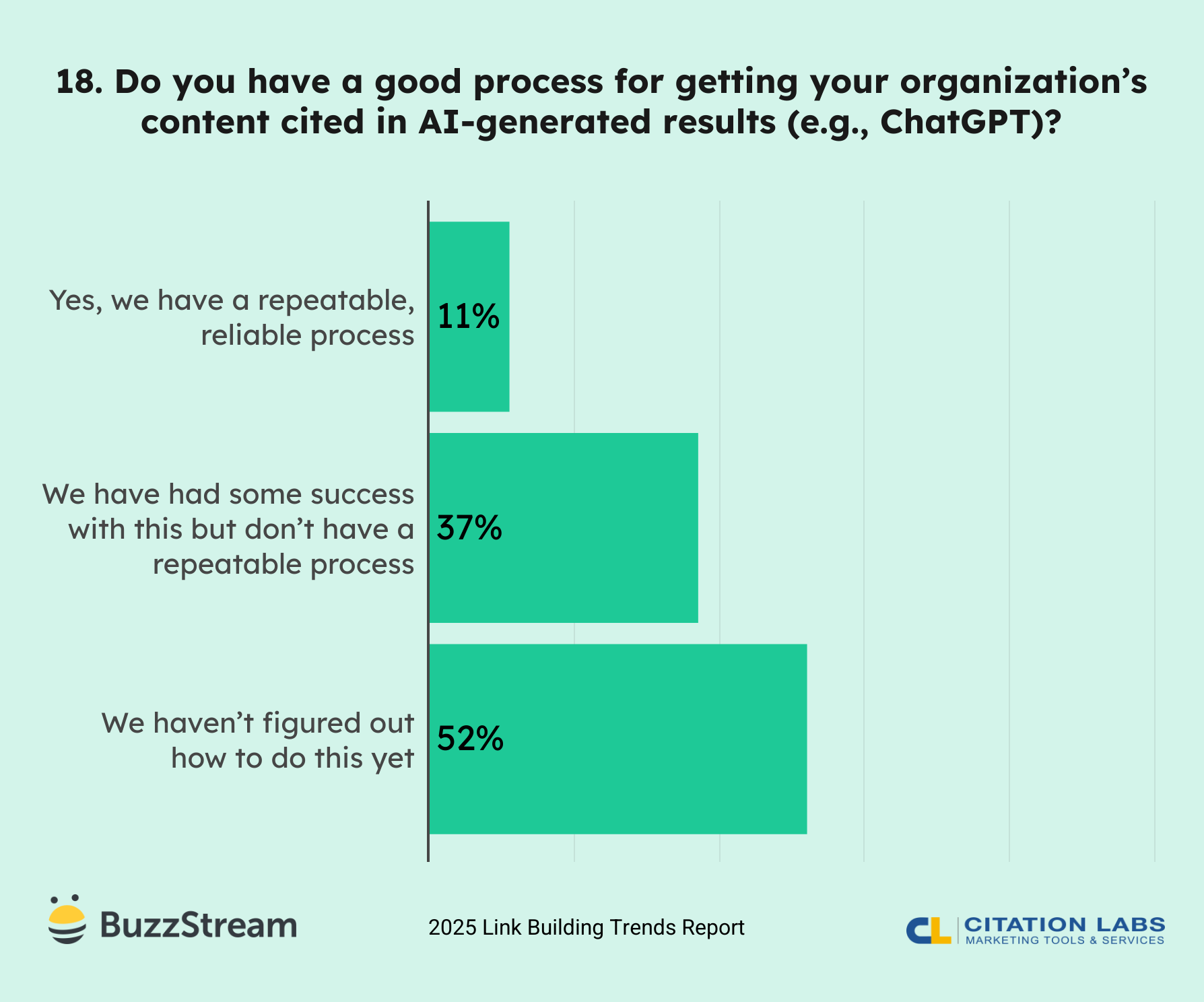
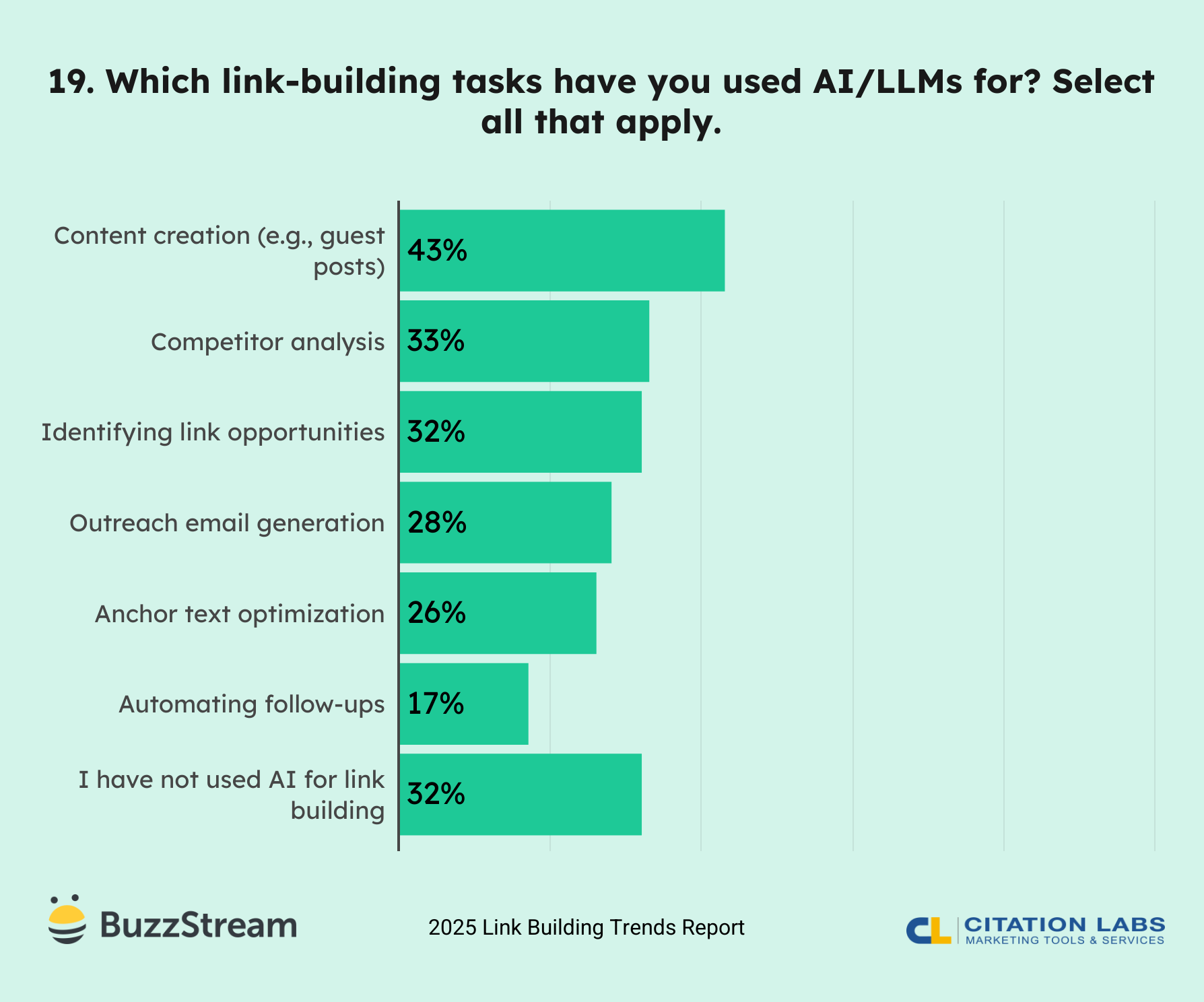
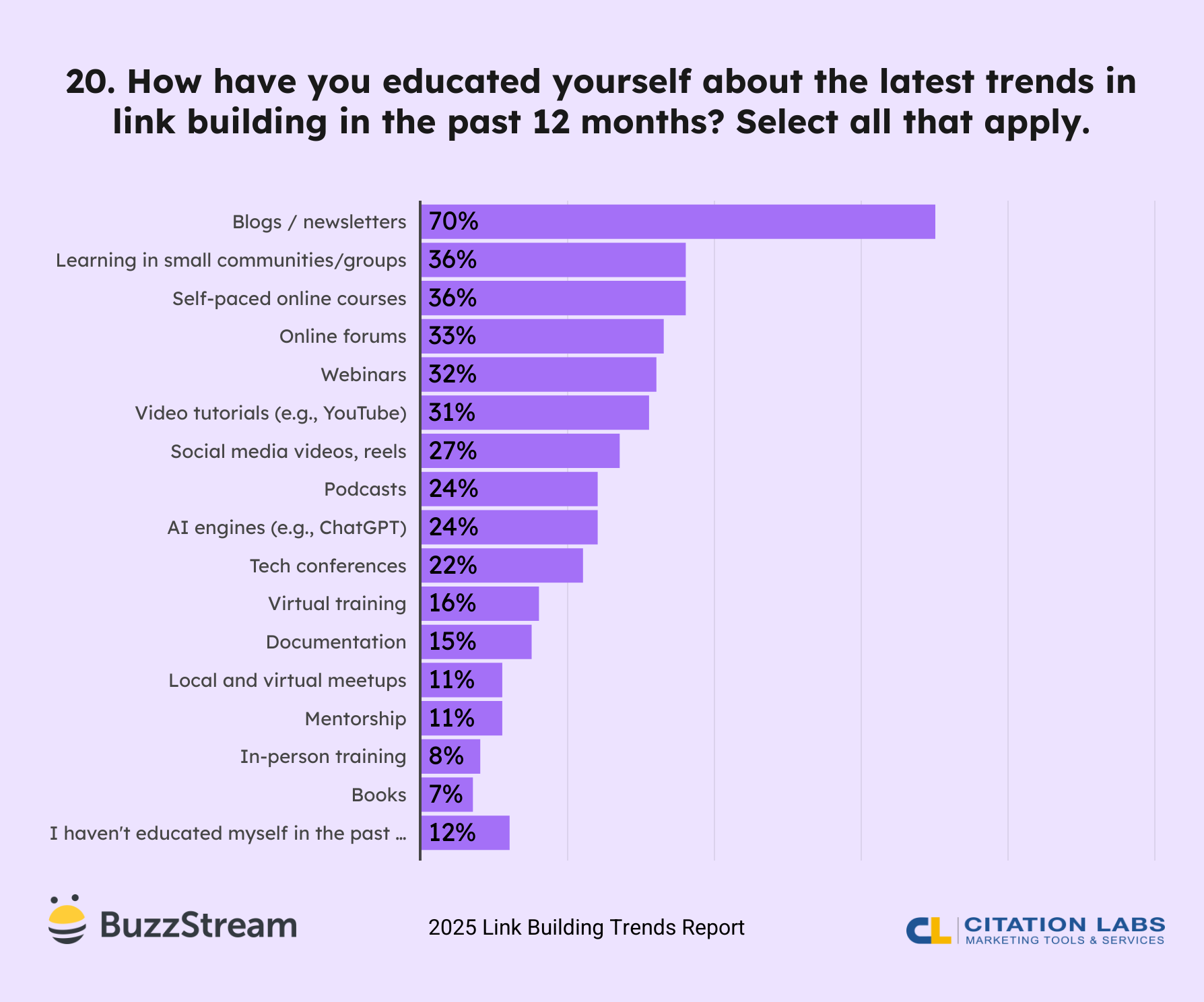
 Check out the BuzzStream Podcast
Check out the BuzzStream Podcast


